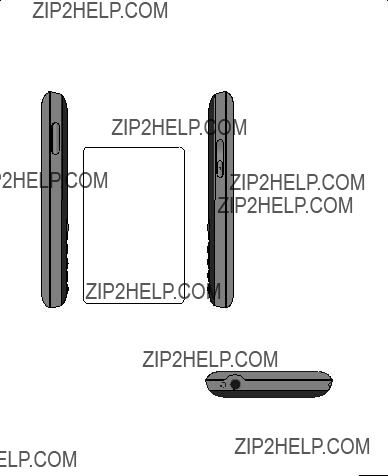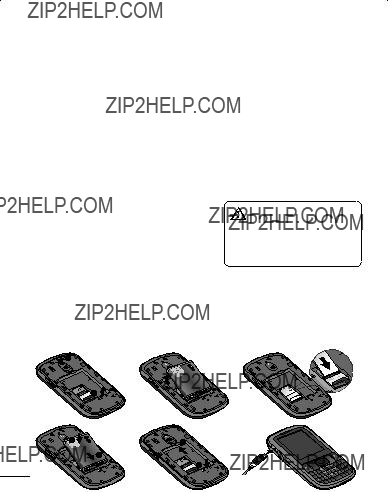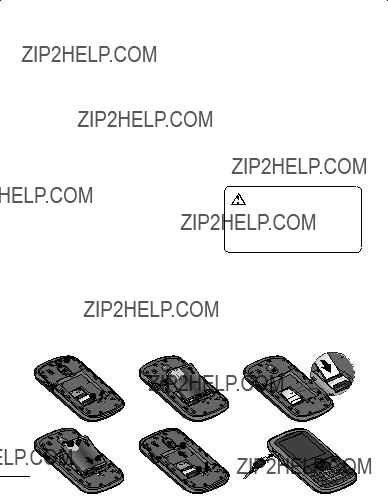
ENGLISH
ESPA??OL
User Manual
LG500G

ENGLISH
ESPA??OL
User Manual
LG500G

Bluetooth QD ID B016785

LG500G User Guide
This guide will help you understand your new mobile phone. It will provide you with useful explanations of features on your phone.Some of the content of this manual may differ from your phone depending on the software of the phone or your service provider.

Getting to Know Your Phone
2

 Charger/USB Port
Charger/USB Port
TIP: Please ensure the phone is powered on , the microSD card is inserted and the phone is in standby mode before connecting the USB cable for Mass Storage.

 Handstrap Hole
Handstrap Hole

 Volume Keys
Volume Keys
???In standby mode:
Controls the ringer volume.
???During a call:
Controls the earpiece volume.
??? When playing music:
Controls the volume for the music.
 Headset Port
Headset Port
3

Installing the SIM Card and Charging the Battery
Installing the SIM Card
When you subscribe to a cellular network, you are provided with a SIM card loaded with your subscription details, such as your PIN, any optional services available and many others.
Important! The SIM card can be easily damaged by scratches or bending, so be careful when handling, inserting or removing the card. Keep all SIM cards out of the reach of small children.
Ilustrations
1 Remove the back cover by sliding it downwards.
2 Lift the battery up and remove it using the fingertip cutout near the top of the battery compartment.
3 Insert the SIM card. Make sure the gold area is facing downwards.
4 Align the battery contacts with the phone terminals near the bottom of the battery compartment and insert the battery into place.
5 Align the back cover and slide it upwards until it clicks into place.
6 Connect the small end of the charger to the phone and the other end to a wall outlet.
If the phone won???t turn on, or if the display freezes or doesn???t respond, follow the instructions for installing the battery again.
4

Calls
Making a Call
1 Use the keypad to enter the phone number. To delete a digit, press CLR.
2 Press  to initiate the call. 3 To end the call, press
to initiate the call. 3 To end the call, press  .
.
TIP! To enter + when making an international call, press and hold  .
.
Making a Call from Your Contacts
1 Select Menu from the Home screen.
2 Select Contacts and then Names.
3 Using the keypad, enter the first letter of the contact you want to call.
4 Select View and then Call or press  to initiate the call.
to initiate the call.
TIP! You can change the settings on your phone to answer your calls using Answer Mode from Call Settings.
Speed Dialing
You can assign a speed dial number to a contact you call frequently.
To access Speed Dials, select Menu from the Home screen. Then select
Contacts and Speed Dials. You can then add, edit, remove, or call Speed Dials from this menu.
Viewing your Call Log
You can only check the log of missed, received and dialed calls if the network supports Calling Line Identification (CLI) within the service area.
To access your Call Log, select Menu from the Home screen. Then select
Recent Calls and Call Log.
Answering and Rejecting a Call
When your phone rings, press  to answer the call. You can control the volume by pressing the Up and Down Volume Keys.
to answer the call. You can control the volume by pressing the Up and Down Volume Keys.
Press  to reject the incoming call.
to reject the incoming call.
Changing the call settings
You can set
5

???Call Waiting - Be alerted when you have a call waiting. This depends on your network provider.
???Fixed Dial Numbers - Choose a list of numbers that can be called from your phone. You will need your PIN2 code from your operator. Only numbers included in the fixed dial list can be called from your phone.
???Call Reject - Set to Off or On and choose to reject all calls, certain contacts or groups, unregistered numbers or those with no caller ID.
???Send My Number - Choose whether your number will be displayed when you call
someone. This depends on your network provider.
???Auto Redial - Allows you to set the auto redial function when a call attempt has failed.
???Answer Mode - Choose whether to answer the phone using Any key or Send key only.
???Free Call Timer - Choose whether or not to display the call time.
???Minute Minder - Set the Minute Minder to Don???t Use, 30 Seconds, 1 minute, 3 minutes, 5 minutes, Set Time Manually to hear a tone during a call.
???BT Answer Mode - Choose how to answer a call when using a Bluetooth headset. Select Hands- Free or Handset.
???Save New Number - Selecting this option will save numbers that are not already in your contacts upon ending a call.
???TTY - Allows you to activate TTY Mode to communicate via TTY device.
Contacts
Searching for a Contact
1 Select Menu from the Home screen.
2 Select Contacts and then Names.
3 Using the keypad, enter the first letter of the contact you want to call.
4 To scroll through the contacts, use the Navigation Keys.
6

Adding a New Contact
1 From the Home screen, press
Menu, then select Contacts and choose Names.
2 Press Options and select Add New Contact.
3 Enter all the contact information in the fields provided and select
Options and then Done.
Adding a Contact to a Group
You can save your contacts in groups; for example, to keep your work colleagues and family separate. There are a number of groups including
Family, Friends, Colleagues, School and VIP already set up on the phone.
Messaging
Your LG500G includes text messaging, multimedia messaging and can also receive network service messages.
messages into one intuitive mode that is easy to switch between. The default setting for the message editor is text messages.
3 Enter your message.
4 Choose Options and then Insert to add an Image, Video Clip, Sound Clip, Schedule, Business Card, Note, Text Field, Task or Text Template.
5 To send the message, press Options and select Send.
Entering Text
You can enter alphanumeric characters using the phone???s keypad. The following text input methods are available on the phone: ABC Mode and 123 Mode.
Note: Some fields may allow only one text input mode (e.g. telephone numbers in the address book fields).
Sending a Message
1 From the Home screen, press Menu, select Messages and choose Create New Message.
2 A new message editor will open. The message editor combines
Text messages and Multimedia
ABC Mode
This mode allows you to enter letters by pressing the keys labeled with the letters you want.
7

123 Mode
Press the keys that correspond with the digits you want to enter.
Message Folders
From the Home screen, press Menu and select Messages. The folder structure used on your LG500G is fairly
Outbox - This is a temporary storage folder while messages are being sent. It also stores any messages that have failed to send. Sent Items - All the messages you send are placed in your Sent folder. Saved Items - You can access your saved messages, text templates and multimedia templates here. Emoticons - A list of useful pre- loaded emoticons that can be used for a quick reply.
Message Settings - You can customize the following Message Settings: Text Message,
Multimedia Message, Voicemail,
and Service Message.
My Folder
You can store any kind of media file on your phone???s memory to give you easy access to all of your images, sounds, videos, etc. You can also save your files to a memory card. The advantage of using a memory card is that you
can free up space on your phone???s memory. All your multimedia files will be saved in My Folder. From the Home screen, press Menu and select My Folder to access your saved files.
My Memory Card
If you have inserted a memory card, it will be displayed as a folder in My Folder.
Pictures
The Pictures folder contains a folder of default images on your phone, images downloaded by you, and images taken on your phone???s camera.
8

Sounds
The Sounds folder contains default sounds, your voice recordings and sound files downloaded by you. From here you can manage and send sounds, or set them as ringtones.
Videos
The Videos folder shows the list of downloaded videos and videos you have recorded on your phone.
Other Files
In the Other Files folder, you can view files that are not saved in the Pictures, Sounds or Videos folders.
Camera
Taking a Quick Photo
1 From the Home screen, press Menu and then My Folder.
2 Select Camera to open the camera application.
3 Holding the phone, point the lens toward the subject of the photo.
4 Press Capture  to take a photo.
to take a photo.
Video
Recording a Quick Video
1 From the Home screen, press
Menu and select My Folder.
2 Select Video to open the video camera application.
3 Point the camera lens toward the subject of the video.
4 Press Rec.  to start recording.
to start recording.
5 ???Rec??? will appear on the viewfinder and a timer will show the length of your video.
6 Select Stop to stop recording.
Music
Your LG500G has a Music player so you can play all your favorite music.
1 From the Home screen, press Menu and select My Folder.
2 Select Music to open the music player application.
Playing a Song
1 From the Home screen, press Menu, select My Folder, then choose
Music.

3 Select 
 to pause the song.
to pause the song.
4 Select 
 to skip to the next song.
to skip to the next song.
5Select 
 to skip to the previous song.
to skip to the previous song.
6 Select Back to stop the music and return to the All Tracks list.
1 From the Home screen, press Menu, select Tools, and choose
Alarm Clock.
2 Press Options and select Add New.
3 Configure your alarm and select
Done.
Voice Recorder
Use your Voice Recorder to record voice memos or other sounds.
Recording a voice memo
1 From the Home screen, press
Menu and select My Folder. Then choose Voice Recorder.
2 Select Rec. to begin recording.
3 Select Stop to end the recording.
4 Press Options and select Play to listen to the recording.
Games & Apps
Allows you to use
Tools
Setting your Alarm
You can set up to five alarms to go off at a specified time.
Using the Calendar and adding an event
When you enter this menu, a calendar appears. A square cursor is located on the current date. You can move the cursor to another date using the Navigation Keys.
1 From the Home screen, press Menu, select Tools, and choose
Calendar.
2 Highlight the day where you want to enter a new event and press Options. Then choose
Add New.
3 Enter the necessary information and press Done.
Adding an Item to Your To- Do List
You can view, edit and add tasks to do.
10

1 From the Home screen, press Menu and choose Tools.
2 Select
Add.
3 Set the date for the
4 Save your
Adding a note
1 From the Home screen, press Menu, select Tools, then choose
Notes.
2 Select Add and type your note.
3 Select Save to save your note.
Secret Notes
You can write private notes to protect your privacy. You need to enter the Security Code to use this menu. The default Security Code is 0000 (four zeros).
Using the Calculator
The calculator provides the basic arithmetic functions - addition, subtraction, multiplication and division - as well as scientific functions.
1 From the Home screen, press Menu, select Tools, then choose
Calculator.
2 Press the numeric keys to input numbers.
3 For simple calculations, select the function you require (+,
4 For more complex calculations, select Options.
5 Select CLR to clear the screen and start a new calculation.
Using the Stopwatch
This option allows you to use stopwatch functions.
1 From the Home screen, press Menu, select Tools, then choose
Stopwatch.
2 Select Start to begin the timer.
3 Choose Lap if you want to record a lap time. Up to 20 lap times can be saved.
4 Select Stop to end the timer.
5 Choose Resume to restart the stopwatch at the time you stopped it or select Reset to return to zero.
11

Date Finder
Date Finder is a handy tool to help you calculate what the date will be once a certain number of days have passed.
Converting Units
You can use the Converter application to convert many measurements into the unit you want.
1 From the Home screen, press Menu, choose Tools, then
choose Converter.
2 Select the type of measurement you want to convert.
3 Scroll left and right to select a unit, then scroll down and enter the unit quantity.
4 Scroll down to the unit conversion box and choose the unit measurement you want to convert into. The amount will be automatically converted.
city, press Options and select
Add City.
3 Scroll down the list or enter the first letter of the city. You can also select Map and choose a city from the map.
4 Press Select to add the city to your city list.
Web
Accessing the Web
You can launch the Browser for fast access to your favorite
websites, add bookmarks, and stay
1 From the Home screen, press
Menu and select Browser.
2 To access the web homepage directly, select Home. Alternately, select Go to Address and type in your desired URL.
Adding a City to Your World Time
1 From the Home screen, press Menu, select Tools, then choose
World Time.
2 To find out the time of a specific
Connectivity
Changing Your Bluetooth
Settings
1 From the Home screen, press Menu and select Settings. Then
12

select Connectivity and choose
Bluetooth.
2 Choose Settings for the following options:
???My Device Visibility - Choose whether to show or hide your device to others.
???My Device Name - Enter a name for your LG500G so other devices can identify you easily.
???Supported Service - Shows what Bluetooth services are supported.
???My Address - View your Bluetooth address.
Pairing with Another
Bluetooth Device
By pairing your LG500G and another device, your handset will create a password by default every time you connect to another handset via Bluetooth.
1 Check that the Bluetooth function is Activated and set to Visible. You can change your visibility in the Settings menu by selecting My Device Visibility and then Visible for 3 Min.
2 Select Search New Device from the Bluetooth menu.
3 Your LG500G will search for devices. When the search is complete, Add and Refresh will appear on the screen.
4 Highlight the device you want to pair with, select Add.
5 Enter the passcode or verify that it matches the passcode on the other device by selecting Yes.
6 Your phone will then connect to the other device. The same passcode will need to be entered or verified on this device.
7 Your
Settings
Changing Your Profiles
You can personalize each profile setting.
1 From the Home screen, press Menu, select Settings, and then choose Profiles.
2 Highlight the Profile you wish to change using the Navigation Keys and select Options and then Edit.
13

3 You can change all of the tones, its volumes and alert options from this menu.
Using Flight Mode
Use this function to activate and deactivate Flight Mode. You will not be able to make calls, connect to the Internet, or send messages when Flight Mode is set to On.
1 From the Home screen, press Menu, select Settings, and then choose
Profiles.
2Select Flight Mode and then Yes to confirm that you want to enable it.
Changing Your Security
Settings
Change your security settings to keep your LG500G and your personal information protected.
1 From the Home screen, press
Menu and select Settings.
2 Select Security and choose from the following options:
???PIN Code Request - Choose a PIN code to be requested when you turn your phone on.
???Phone Lock - Allows you to lock your phone immediately.
???Lock If SIM is Changed - Locks the phone when the SIM card is changed.
???Change Codes - Allows you to change your PIN Code, PIN2 Code, or Security Code.
Viewing memory status
You can use the memory manager to determine how each memory is used and see how much space is available in the Handset Common Memory, Handset Reserved Memory, SIM Memory or External Memory. If an external memory card is inserted in your phone, you can also select Primary Storage Settings and choose the default location you prefer items to be saved to.
1 From the Home screen, press
Menu, select Settings, and choose Memory Info.
2 The different memory locations are displayed on the screen. Choose an option to view the status.
14

Accessories
Various accessories are available for your mobile phone. These are detailed below.
NOTE
???Always use genuine LG accessories. Failure to do so may invalidate your warranty.
???Accessories may be different in different regions. Please check with our regional service company or agent for further information.
15

Troubleshooting
This section lists some problems that you might encounter while using your phone. Some problems require that you call your service provider, but most of problems you encounter are easy to correct yourself.
Move to a window or open space. Check service provider coverage map.
Press On/Off key for at least two seconds.
Charge battery. Check charging indicator in the display.
Clean the battery contacts.
16

No power from outlet.
Charger defective.
Wrong charger.
Battery defective.
Charge battery.
Check power supply and connection to the phone. Check the battery contacts, clean them if necessary.
Plug in to a different socket or check voltage.
Test with another charger.
Only use original LG accessories. Replace battery.
Check the Settings menu and turn the function off.
17

For Your Safety
Important Information
This user guide contains important information on the use and operation of this phone. Please read all the information carefully for optimal performance and to prevent any damage to or misuse of the phone. Any changes or modifications not expressly approved in this user guide could void your warranty for this equipment. Any changes or modifications not expressly approved by the manufacturer could void
the user???s authority to operate the equipment.
Before You Start
Safety Instructions
WARNING! To reduce the possibility of electric shock, do not expose your phone to high humidity areas, such as the bathroom, swimming pool, etc.
Always store your phone away from heat. Never store your phone in settings that may expose it to temperatures less than 32??F or greater than 104??F, such as outside during extreme weather conditions or in your car on a hot day. Exposure
18 to excessive cold or heat will result
in malfunction, damage and/or catastrophic failure.
Be careful when using your phone near other electronic devices. RF emissions from your mobile phone may affect nearby in adequately shielded electronic equipment. You should consult with manufacturers of any personal medical devices such as pacemakers and hearing aides to determine if they are susceptible to interference from your mobile phone. Turn off your phone in a medical facility or at a gas station. Never place your phone in a microwave oven as this will cause the battery to explode. IMPORTANT! Please read the TIA SAFETY INFORMATION before using your phone.
Safety Information
Read these simple guidelines. Breaking the rules may be dangerous or illegal. Further detailed information is given in this user guide.
???Do not disassemble this unit. Take it to a qualified service technician when repair work is required.
???Keep away from electrical appliances such as TVs, radios, and personal computers.
???The unit should be kept away from heat sources such as radiators or cookers.

???Do not drop.
???Do not subject this unit to mechanical vibration or shock.
???The coating of the phone may be damaged if covered with wrap or vinyl wrapper.
???Use dry cloth to clean the exterior of the unit. (Do not use solvent such as benzene, thinner or alcohol.)
???Do not subject this unit to excessive smoke or dust.
???Do not keep the phone next to credit cards or transport tickets; it can affect the information on the magnetic strips.
???Do not tap the screen with a sharp object; otherwise, it may damage the phone.
???Do not expose the phone to liquid or moisture.
???Use the accessories like an earphone cautiously. Do not touch the antenna unnecessarily.
Memory card information and care
???The memory card cannot be used for recording copyright- protected data.
???Keep the memory card out of the small children???s reach.
???Do not leave the memory card in extremely hot location.
???Do not disassemble or modify the memory card.
FCC RF Exposure Information
WARNING! Read this information before operating the phone.
In August 1996, the Federal
Communications Commission (FCC) of the United States, with its action in Report and Order FCC
The design of this phone complies with the FCC guidelines and these international standards.
CAUTION
Use only the supplied and approved antenna. Use of unauthorized antennas or modifications could impair call quality, damage the phone, void your warranty and/or result
in violation of FCC regulations. Do not use the phone with a damaged antenna. If a damaged antenna comes into contact with skin, a minor burn may result. Contact your local dealer for a replacement antenna.
19

This device was tested for typical
be used.
FCC Part 15 Class B Compliance
This device and its accessories comply with part 15 of FCC rules. Operation is subject to the following two conditions: (1) This device and its accessories may not cause harmful interference, and (2) this device
and its accessories must accept any interference received, including interference that may cause undesired
20 operation.
Part 15.105 statement
This equipment has been tested and found to comply with the limits for a class B digital device, pursuant to Part 15 of the FCC Rules. These limits are designed to provide reasonable protection against harmful interference in a residential installation. This equipment generates uses and can radiate radio frequency energy and, if not installed and used in accordance with the instructions, may cause harmful interference to radio communications. However, there is no guarantee that interference will not occur in a particular installation. If this equipment does cause harmful interference or television reception, which can be determined by turning the equipment off and on, the user
is encouraged to try to correct the interference by one or more of the following measures:
???Reorient or relocate the receiving antenna.
???Increase the separation between the equipment and receiver.
???Connect the equipment into an outlet on a circuit different from that to which the receiver is connected.
???Consult the dealer or an experienced radio/TV technician for help.

Cautions for Battery
???Do not disassemble or open crush, bend or deform, puncture or shred.
???Do not modify or remanufacture, attempt to insert foreign objects into the battery, immerse or expose to water or other liquids, expose to fire, explosion or other hazard.
???Only use the battery for the system for which it is specified.
???Only use the battery with a charging system that has been qualified with the system per this standard. Use of an unqualified battery or charger may present a risk of fire, explosion, leakage, or other hazard.
???Do not short circuit a battery or allow metallic conductive objects to contact battery terminals.
???Replace the battery only with another battery that has been qualified with the system per this standard,
???Promptly dispose of used batteries in accordance with local regulations.
???Battery usage by children should be supervised.
???Avoid dropping the phone or battery. If the phone or battery is dropped, especially on a hard surface, and the user suspects damage, take it to a service center for inspection.
???Improper battery use may result in a fire, explosion or other hazard.
???For those host devices that utilize a USB port as a charging source, the host device???s user manual shall include a statement that the phone shall only be connected to products that bear the USB- IF logo or have completed the
Adapter (Charger) Cautions
???Using the wrong battery charger could damage your phone and void your warranty.
???The adapter or battery charger is intended for indoor use only.
Do not expose the adapter or battery charger to direct sunlight or use it in places with high humidity, such as the bathroom.
Avoid damage to your hearing
???Damage to your hearing can occur if you are exposed to loud sound for long periods of time. We therefore
recommend that you do not turn on or off the handset close to your ear. We also recommend that music and call volumes are set to a reasonable level.
???If you are listening to music while out and about, please ensure that the volume is at a reasonable level so that you are aware

Safety Guidelines
TIA Safety Information
Provided herein is the complete TIA Safety Information for Wireless Handheld phones. Inclusion of the text covering Pacemakers, Hearing Aids, and Other Medical Devices is required in the owner???s manual for CTIA Certification. Use of the
remaining TIA language is encouraged when appropriate.
Exposure to Radio Frequency Signal
Your wireless handheld portable telephone is a lowpower radio transmitter and receiver. When it is ON, it receives and also sends out radio frequency (RF) signals.
In August, 1996, the Federal Communications Commissions (FCC) adopted RF exposure guidelines with safety levels for handheld wireless phones. Those guidelines are consistent with the safety standards previously set by both U.S. and international standards bodies:
ANSI C95.1 (1992) * NCRP Report 86 (1986) ICNIRP (1996)
Those standards were based on comprehensive and periodic evaluations of the relevant scientific literature. For example, over 120 scientists, engineers, and physicians from universities, government health agencies, and industry reviewed the available body of research to develop the ANSI Standard (C95.1).
* American National Standards Institute; National Council
on Radiation Protection and Measurements; International Commission on
The design of your phone complies with the FCC guidelines (and those standards).
Antenna Care
Use only the supplied or an approved replacement antenna. Unauthorized antennas, modifications, or attachments could damage the phone and may violate FCC regulations.
Phone Operation
NORMAL POSITION: Hold the phone as you would any other telephone with the antenna pointed up and over your shoulder.
22

Tips on Efficient Operation
For your phone to operate most efficiently:
??? Do not touch the antenna unnecessarily when the phone is in use. Contact with the antenna affects call quality and may cause the phone to operate at a higher power level than otherwise needed.
Driving
Check the laws and regulations on the use of wireless phones in the areas where you drive. Always obey them. Also, if using your phone while driving, please:
???Give full attention to driving - driving safely is your first responsibility;
???Use
???Pull off the road and park before making or answering a call if driving conditions so require.
Electronic Devices
Most modern electronic equipment is shielded from RF signals. However, certain electronic equipment may not be shielded against the RF signals from your wireless phone.
Pacemakers
The Health Industry Manufacturers Association recommends that a minimum separation of six (6???) inches be maintained between a handheld wireless phone and a pacemaker to avoid potential interference with the pacemaker. These recommendations are consistent with the independent research by and recommendations of Wireless Technology Research. Persons with pacemakers:
???Should ALWAYS keep the phone more than six inches from their pacemaker when the phone is turned ON;
???Should not carry the phone in a breast pocket.
???Should use the ear opposite the pacemaker to minimize the potential for interference.
???If you have any reason to suspect that interference is taking place, turn your phone OFF immediately.
Hearing Aids
Some digital wireless phones may interfere with some hearing aids. In the event of such interference, you may want to consult AT&T.
23

Other Medical Devices
If you use any other personal medical device, consult the manufacturer of your device to determine if they are adequately shielded from external RF energy. Your physician may be able to assist you in obtaining this information.
Health Care Facilities
Turn your phone OFF in health care facilities when any regulations posted in these areas instruct you to do so. Hospitals or health care facilities may use equipment that could be sensitive to external RF energy.
Vehicles
RF signals may affect improperly installed or inadequately shielded electronic systems in motor vehicles. Check with the manufacturer or its representative regarding your vehicle. You should also consult the manufacturer of any equipment that has been added to your vehicle.
Posted Facilities
Turn your phone OFF in any facility where posted notices so require.
24
Aircraft
FCC regulations prohibit using your phone while in the air. Turn your phone OFF before boarding an aircraft.
Blasting Areas
To avoid interfering with blasting operations, turn your phone OFF when in a???blasting areas or in areas posted:???Turn off
Potentially Explosive
Atmosphere
Turn your phone OFF when in any area with a potentially explosive atmosphere and obey all signs and instructions. Sparks in such areas could cause an explosion or fire resulting in bodily injury or even death.
Areas with a potentially explosive atmosphere are often, but not always, marked clearly. Potential areas may include: fueling areas (such as gasoline stations); below deck on boats; fuel or chemical transfer or storage facilities; vehicles using liquefied petroleum gas (such as propane or butane); areas where the air contains chemicals or

particles (such as grain, dust, or metal powders); and any other area where you would normally be advised to turn off your vehicle engine.
For Vehicles Equipped with an Air Bag
An air bag inflates with great force. DO NOT place objects, including either installed or portable wireless equipment, in the area over the air bag or in the air bag deployment area. If
Charger and Adapter Safety
???The charger and adapter are intended for indoor use only.
Battery Information and Care
???Please dispose of your battery properly or take it to your local wireless carrier for recycling.
???The battery does not need to be fully discharged before recharging.
???Use only
???Do not disassemble or impact the battery as it may cause electric shock,
???Keep the battery???s metal contacts clean.
???Replace the battery when it no longer provides acceptable performance. The battery can be recharged several hundred times before replacement.
???Recharge the battery after long periods of
???Battery life will vary due to usage patterns and environmental conditions.
???Use of extended backlighting, MEdia Net Browsing, and data connectivity kits affect battery life and talk/standby times.
???The
???Actual battery life will depend on network configuration, product settings, usage patterns, battery and environmental conditions.
Explosion, Shock, and Fire
Hazards
???Do not put your phone in a place subject to excessive dust and keep the minimum required distance between the power cord and heat sources.
25

???Unplug the power cord prior to cleaning your phone, and clean the power plug pin when it is dirty.
???When using the power plug, ensure that it is firmly connected. If it is not, it may cause excessive heat or fire.
???If you put your phone in a pocket or bag without covering the receptacle of the phone (power plug pin), metallic articles (such as a coin, paperclip or pen) may
???Do not
??? terminals of the battery (metal strips on the battery) upon moving. Short- circuit of the terminal may damage the battery and cause an explosion.
General Notice
???Using a damaged battery or placing a battery in your mouth may cause serious injury.
???Do not place items containing magnetic components such as a credit card, phone card, bank book or subway ticket near your phone. The magnetism of the phone may damage the data stored in the magnetic strip.
???Talking on your phone for a long period of time may reduce call quality due to heat generated during use.
???When the phone is not used for a long period time, store it in a safe place with the power cord unplugged.
???Using the phone in proximity to receiving equipment (i.e., TV or radio) may cause interference to the phone.
???Do not use the phone if the antenna is damaged. If a damaged antenna contacts skin, it may cause a slight burn. Please contact an LG Authorized Service Center to replace the damaged antenna.
???Do not immerse your phone in water. If this happens, turn it off immediately and remove the battery. If the phone does not work, take it to an LG Authorized Service Center.
???Do not paint your phone.
???The data saved in your phone might be deleted due to careless use, repair of the phone, or upgrade of the software. Please backup your important phone numbers. (Ring tones, text messages, voice messages, pictures, and videos could also be deleted.) The manufacturer is not liable for damage due to the loss
of data.
???When you use the phone in public places, set the ring tone to vibration so as not to disturb others.
???Do not turn your phone on or off when putting it in your ear.
26

FDA Consumer Update
The U.S. Food and Drug Administration Center for Devices and Radiological Health Consumer Update on Mobile Phones.
1.Do wireless phones pose a health hazard?
The available scientific evidence does not show that any health problems are associated with using wireless phones. There is no proof, however, that wireless phones are absolutely safe. Wireless phones emit low levels of radiofrequency energy (RF) in the microwave range while being used. They also emit very low levels of RF when in the Home screen. Whereas high levels of RF can produce health effects (by heating tissue), exposure to low level RF that does not produce heating effects causes no known adverse health effects. Many studies of low level RF exposures have not found any biological effects. Some studies have suggested that some biological effects may occur, but such findings have not been confirmed by additional research. In some cases, other researchers have had difficulty in reproducing those studies, or in determining the reasons for inconsistent results.
2.What is the FDA???s role concerning the safety of wireless phones?
Under the law, the FDA does not review the safety of radiation- emitting consumer products such as wireless phones before they can be sold, as it does with new drugs or medical devices. However, the agency has authority to take action if wireless phones are shown to emit radiofrequency energy (RF) at a level that is hazardous to the user. In such a case, the FDA could require the manufacturers of wireless phones to notify users of the health hazard and to repair, replace, or recall the phones so that the hazard no longer exists. Although the existing scientific data do not justify FDA regulatory actions, the FDA has urged the wireless phone industry to take a number of steps, including the following:
???Support needed research into possible biological effects of RF of the type emitted by wireless phones;
???Design wireless phones in a way that minimizes any RF exposure to the user that is not necessary for device function; and
???Cooperate in providing users of wireless phones with the best possible information on possible effects of wireless phone use on human health. 27

The FDA belongs to an interagency working group of the federal agencies that have responsibility for different aspects of RF safety to ensure coordinated efforts at the federal level. The following agencies belong to this working group:
???National Institute for Occupational Safety and Health
???Environmental Protection Agency
???Occupational Safety and Health Administration (Administraci??n de la seguridad y salud laborales)
???Occupational Safety and Health Administration
???National Telecommunications and Information Administration
The National Institutes of Health participates in some interagency working group activities, as well. The FDA shares regulatory responsibilities for wireless phones with the Federal Communications Commission (FCC). All phones that are sold in the United States must comply with FCC safety guidelines that limit RF exposure. The FCC relies on the FDA and other health agencies for safety questions about wireless phones.
The FCC also regulates the base stations that the wireless phone networks rely upon. While these base stations operate at higher power than do the wireless phones themselves, the RF exposures that people get from these base stations are typically thousands of times lower than those they can get from wireless phones. Base stations are thus not the subject of the safety questions discussed in this document.
3.What kinds of phones are the subject of this update?
The term???wireless phone???refers here to handheld wireless phones with
28

distance from the source. The so- called???cordless phones,???which have a base unit connected to the telephone wiring in a house, typically operate at far lower power levels, and thus produce RF exposures far below the FCC safety limits.
4.What are the results of the research done already?
The research done thus far has produced conflicting results, and many studies have suffered from flaws in their research methods. Animal experiments investigating the effects of radiofrequency energy (RF) exposures characteristic of wireless phones have yielded conflicting results that often cannot be repeated in other laboratories. A few animal studies, however, have suggested that low levels of RF could accelerate the development of cancer in laboratory animals. However, many of the studies that showed increased tumor development used animals that
had been genetically engineered or treated with cancer causing chemicals so as to be
conditions are not similar to the conditions under which people use wireless phones, so we don???t know with certainty what the results of such studies mean for human health. Three large epidemiology studies have been published since December 2000. Between them, the studies investigated any possible association between the use of wireless phones and primary brain cancer, glioma, meningioma, or acoustic neuroma, tumors of the brain or salivary gland, leukemia, or other cancers. None
of the studies demonstrated the existence of any harmful health effects from wireless phone RF exposures. However, none of the studies can answer questions about
5.What research is needed to decide whether RF exposure from wireless phones poses a health risk?
Acombination of laboratory studies and epidemiological studies of people actually using wireless phones would provide some of the data that are needed. Lifetime animal exposure
29

studies could be completed in a few years. However, very large numbers of animals would be needed to provide reliable proof of a cancer promoting effect if one exists. Epidemiological studies can provide data that is directly applicable to human populations, but 10 or more years
is used.
6.What is the FDA doing to find out more about the possible health effects of wireless phone RF?
The FDA is working with the U.S. National Toxicology Program and with groups of investigators around the world to ensure that high priority animal studies are conducted
to address important questions
30
about the effects of exposure to radiofrequency energy (RF). The FDA has been a leading participant in the World Health Organization International Electromagnetic Fields (EMF) Project since its inception in 1996. An influential result of this work has been the development of a detailed agenda of research needs that has driven the establishment of new research programs around the world. The project has also helped develop a series of public information documents on EMF issues. The FDA and the Cellular Telecommunications & Internet Association (CTIA) have
a formal Cooperative Research and Development Agreement (CRADA) to do research on wireless phone safety. The FDA provides the scientific oversight, obtaining input from experts in government,
industry, and academic organizations.
will include both laboratory studies and studies of wireless phone users. The CRADA will also include a broad assessment of additional research needs in the context of the latest research developments around the world.

7.How can I find out how much radio frequency energy exposure I can get by using my wireless phone?
All phones sold in the United States must comply with Federal Communications Commission (FCC) guidelines that limit radio frequency energy (RF) exposures. The FCC established these guidelines in consultation with the FDA and the other federal health and safety agencies. The FCC limit for RF exposure from wireless telephones is set at a Specific Absorption Rate (SAR) of 1.6 watts per kilogram (1.6 W/kg). The FCC limit is consistent with the safety standards developed by the Institute of Electrical and Electronic Engineering (IEEE) and the National Council on Radiation Protection and Measurement. The exposure limit takes into consideration the body???s ability to remove heat from the tissues that absorb energy from the wireless phone and is set well below levels known to have effects. Manufacturers of wireless phones must report the RF exposure level for each model of phone to the FCC. The FCC website (http://www.fcc.gov/oet/rfsafety) gives directions for locating the FCC
identification number on your phone so you can find your phone???s RF exposure level in the online listing.
8.What has the FDA done to measure the radio frequency energy coming from wireless phones?
The Institute of Electrical and Electronic Engineers (IEEE) is developing a technical standard for measuring the radio frequency energy (RF) exposure from wireless phones and other wireless handsets with the participation and leadership of FDA scientists and engineers.
The standard,???Recommended Practice for Determining the Spatial- Peak Specific Absorption Rate (SAR) in the Human Body Due to Wireless Communications Devices: Experimental Techniques,???sets forth the first consistent test methodology for measuring the rate at which RF is deposited in the heads of wireless phone users. The test method uses a tissuesimulating model of the human head. Standardized SAR
test methodology is expected to greatly improve the consistency of measurements made at different laboratories on the same phone. SAR is the measurement of the amount
31

of energy absorbed in tissue, either by the whole body or a small part of the body. It is measured in watts/kg (or milliwatts/g) of matter. This measurement is used to determine whether a wireless phone complies with safety guidelines.
9.What steps can I take to reduce my exposure to radiofrequency energy from my wireless phone?
If there is a risk from these products - and at this point we do not know that there is - it is probably very small. But if you are concerned about avoiding even potential risks, you can take a few simple steps to minimize your exposure to radiofrequency energy (RF). Since time is a key factor in how much exposure a person receives, reducing the amount of time spent using a wireless phone will reduce RF exposure. If you must conduct extended conversations by wireless phone every day, you could place more distance between your body and the source of the RF, since the exposure level drops off dramatically with distance. For example, you could use a headset and carry the wireless phone away from your body or use a wireless phone connected to a remote
antenna. Again, the scientific data do not demonstrate that wireless phones are harmful. But if you are concerned about the RF exposure from these products, you can use measures like those described above to reduce your RF exposure from wireless phone use.
10.What about children using wireless phones?
The scientific evidence does not show a danger to users of wireless phones, including children and teenagers. If you want to take steps to lower exposure to radiofrequency energy (RF), the measures described above would apply to children and teenagers using wireless phones. Reducing the time of wireless phone use and increasing the distance between the user and the RF source will reduce RF exposure. Some groups sponsored by other national governments have advised that children be discouraged from using wireless phones at all. For example, the government in the United Kingdom distributed leaflets containing such a recommendation in December 2000. They noted that no evidence exists that using a wireless phone causes brain tumors or other
32

ill effects. Their recommendation to limit wireless phone use by children was strictly precautionary; it was not based on scientific evidence that any health hazard exists.
11.What about wireless phone interference with medical equipment?
Radio frequency energy (RF) from wireless phones can interact with some electronic devices. For this reason, the FDA helped develop a detailed test method to measure electromagnetic interference (EMI) of implanted cardiac pacemakers and defibrillators from wireless telephones. This test method is now part of a standard sponsored by the Association for the Advancement of Medical instrumentation (AAMI). The final draft, a joint effort by the FDA, medical device manufacturers, and many other groups, was completed in late 2000. This standard will allow manufacturers to ensure that cardiac pacemakers and defibrillators are safe from wireless phone EMI. The FDA has tested hearing aids for interference from handheld wireless phones and helped develop a voluntary standard sponsored by the Institute of Electrical
and Electronic Engineers (IEEE). This standard specifies test methods and performance requirements for hearing aids and wireless phones so that no interference occurs when a person uses a???compatible???phone and a???compatible???hearing aid at the same time. This standard was approved by the IEEE in 2000. The FDA continues to monitor the use of wireless phones for possible interactions with other medical devices. Should harmful interference be found to occur, the FDA will conduct testing to assess the interference and work to resolve the problem.
12.Where can I find additional information?
For additional information, please refer to the following resources: FDA web page on wireless phones (http://www.fda.gov/Radiation- EmittingProducts/ RadiationEmittingProductsandProcedures / HomeBusinessandEntertainment / CellPhones/default.htm)
Federal Communications Commission (FCC) RF Safety Program (http://www.fcc.gov/oet/rfsafety)
33

International Commission on Non- lonizing Radiation Protection (http://www.icnirp.de)
World Health Organization (WHO) International EMF Project
10 Driver Safety Tips
Your wireless phone gives you the powerful ability to communicate by voice almost anywhere, anytime. An important responsibility accompanies the benefits of wireless phones, one that every user must uphold.
When operating a car, driving is your first responsibility.
When using your wireless phone behind the wheel of a car, practice good common sense and remember the following tips:
1.Get to know your wireless phone and its features such as speed dial and redial. Carefully read your instruction manual and learn to take advantage of valuable features most phones offer, including automatic redial and memory.
Also, work to memorize the phone keypad so you can use the speed dial function without taking your attention off the road.
2.When available, use a
3.Position your wireless phone within easy reach. Make sure you place your wireless phone within easy reach and where you can reach it without removing your eyes from the road. If you get an incoming call at an inconvenient time, if possible, let your voicemail answer it for you.
4.Suspend conversations during hazardous driving conditions or situations. Let the person you are speaking with know you are driving; if necessary, suspend the call in heavy traffic or hazardous weather conditions. Rain, sleet, snow and ice can be hazardous, but so is heavy traffic. As a driver, your first responsibility is to pay attention to the road.
34

5.Do not take notes or look up phone numbers while driving. If you
are reading an Address Book or business card, or writing
6.Dial sensibly and assess the traffic; if possible, place calls when you are not moving or before pulling into traffic. Try to plan your calls before you begin your trip or attempt to coincide your calls with times you may be stopped at a stop sign, red light or otherwise stationary. But
if you need to dial while driving, follow this simple tip??? dial only a few numbers, check the road and your mirrors, then continue.
7.Do not engage in stressful or emotional conversations that may be distracting. Stressful or emotional conversations and driving do not mix; they are distracting and even dangerous when you are behind the wheel of a car. Make people you are talking
with aware you are driving and if necessary, suspend conversations which have the potential to divert your attention from the road.
8.Use your wireless phone to call for help. Your wireless phone is one of the greatest tools you can own to protect yourself and your family in dangerous situations ??? with your phone at your side, help is only three numbers away. Dial 911 or other local emergency number in the case of fire, traffic accident, road hazard or medical emergency. Remember, it is a free call on your wireless phone!
9.Use your wireless phone to help others in emergencies. Your wireless phone provides you a perfect opportunity to be a???Good Samaritan???in your community. If you see an auto accident, crime in progress or other serious emergency where lives are in danger, call 911 or other local emergency number, as you would want others to do for you.
35

10.Call roadside assistance or a special wireless
For more information, please call to
Consumer Information on SAR
(Specific Absorption Rate)
This Model Phone Meets the Government???s Requirements for Exposure to Radio Waves.
Your wireless phone is a radio transmitter and receiver. It is designed and manufactured not to exceed the emission limits for exposure to radio frequency (RF) energy set by the Federal Communications Commission (FCC) of the U.S. Government. These limits are part of comprehensive guidelines and establish permitted levels of RF energy for the general population. The guidelines are based on standards that were developed by independent scientific organizations through periodic and thorough evaluation of scientific studies. The standards include a substantial safety margin designed to assure the safety of all persons, regardless of age and health.
The exposure standard for wireless mobile phones employs a unit of measurement known as the Specific Absorption Rate, or SAR. The SAR limit set by the FCC is 1.6W/kg.
36

* Tests for SAR are conducted using standard operating positions specified by the FCC with the phone transmitting at its highest certified power level in all tested frequency bands. Although SAR is determined at the highest certified power level, the actual SAR level of the phone while operating can be well below the maximum value. Because the phone is designed to operate at multiple power levels to use only the power required to reach the network, in general, the closer you are to a wireless base station antenna, the lower the power output.
Before a phone model is available for sale to the public, it must be tested and certified to the FCC that it does not exceed the limit established
by the
models, depending upon available accessories and FCC requirements.) While there may be differences between SAR levels of various phones and at various positions, they all meet the government requirement for safe exposure.
The FCC has granted an Equipment Authorization for this model phone with all reported SAR levels evaluated as in compliance with the FCC RF emission guidelines. SAR information on this model phone is on file with the FCC and can be found under the Display Grant section of http://www. fcc.gov/oet/fccid after searching on FCC ID BEJC500G.
Additional information on Specific Absorption Rates (SAR) can be found on the Cellular Telecommunications Industry Association (CTIA) website at http://www.ctia.org
* In the United States and Canada, the SAR limit for mobile phones used by the public is 1.6 watts/kg (W/kg) averaged over one gram of tissue. The standard incorporates a substantial margin of safety to give additional protection for the public and to account for any variations in measurements.
37

Hearing Aid Compatibility
(HAC) with Mobile Phones
When some mobile phones are used near some hearing devices (hearing aids and cochlear implants),users may detect a buzzing, humming, or whining noise. Some hearing devices are more immune than others to this interference noise, and phones also vary in the amount of interference they generate. The wireless telephone industry has developed ratings for some of their mobile phones, to assist hearing device users in finding phones that may be compatible with their hearing devices. Not all phones have been rated. Phones that are rated have the rating on their box or a label on the box. The ratings are not guarantees. Results will vary depending on the user???s hearing device and hearing loss. If your hearing device happens to be vulnerable to interference, you may not be able to use a rated phone successfully. Trying out the phone with your hearing device is the best way to evaluate it for your personal needs.
Hearing devices may also be measured for immunity to this type of interference. Your hearing device manufacturer or hearing health professional may help you find results for your hearing device. The more immune your hearing aid is, the less likely you are to experience interference noise from mobile phones.
To ensure that the Hearing Aid Compatibility rating for your phone is maintained, secondary transmitters such as Bluetooth?? components must be disabled during a call.
38

Gu??a del usuario de LG500G
Esta gu??a lo ayudar?? a entender el nuevo tel??fono celular. Le proporcionar?? explicaciones ??tiles sobre las funciones del tel??fono. Es posible que parte del contenido de esta gu??a no coincida con el tel??fono dependiendo del software del tel??fono o del proveedor de servicios.

Para conocer el tel??fono
Auricular
LCD principal
Tecla Enviar
???Permite realizar llamadas a n??meros de tel??fono y
responder llamadas entrantes.
??? En modo de espera: muestra el Registro de llamadas.
Teclas alfanum??ricas
Teclas de funci??n (Teclas de funci??n izquierda y derecha)
???Estas teclas realizan las funciones indicadas en la parte inferior de la pantalla sobre cada tecla.
Tecla Men??/Tecla
Aceptar
???Permite seleccionar las opciones de men?? y confirmar las acciones.
Tecla Finalizar
???Mantenga presionado para encender y apagar el tel??fono.
???Finaliza o rechaza una llamada.
Teclas de navegaci??n
2

 Puerto para cargador y cable USB
Puerto para cargador y cable USB
SUGERENCIA:
Aseg??rese de que el tel??fono est?? encendido, en modo de espera y la tarjeta de memoria est?? insertada antes de conectar el cable USB para el almacenamiento masivo.

 Orificio para cinta
Orificio para cinta

 Teclas de volumen
Teclas de volumen
???En modo en espera: permiten controlar el volumen de timbre.
???Durante una llamada: permiten
ajustar el volumen del auricular.
??? Durante la reproducci??n de m??sica: permite controlar el volumen de la m??sica.
 Puerto para auricular
Puerto para auricular
3

Instalaci??n de la tarjeta SIM y carga de la bater??a
Cuando se suscribe a una red celular, se le suministra una tarjeta SIM que tiene cargados los detalles de suscripci??n, por ejemplo, el PIN, servicios opcionales disponibles y muchos otros detalles.
??Importante! La tarjeta SIM puede da??arse con facilidad si se raya o dobla, por lo tanto, sea cuidadoso al manipularla, insertarla o extraerla. Mantenga todas las tarjetas SIM fuera del alcance de ni??os.
Ilustraciones
1 Deslice la tapa posterior hacia abajo para extraerla.
2 Levante la bater??a y use la abertura de dedos en la parte superior del
compartimiento de bater??a para extraerla.
3 Inserte la tarjeta SIM. Aseg??rese que la ??rea dorada est?? orientada hacia abajo.
4 Alinee los contactos de la bater??a con los
terminales del tel??fono en la parte inferior del compartimiento de la bater??a e inserte la bater??a en su lugar.
5 Alinee la tapa posterior y desl??cela hacia arriba hasta que encaje en su lugar.
6 Conecte el extremo chico del cargado al tel??fono y el otro extremo a un tomacorriente. Si el tel??fono no se enciende, o si la pantalla de congela o no
responde, siga las instrucciones para instalar la bater??a nuevamente.
4

Llamadas
Hacer una llamada
1 Use el teclado para introducir el n??mero de tel??fono.
2 Presione  para iniciar la llamada.
para iniciar la llamada.
3 Para finalizar la llamada, presione
 .
.
SUGERENCIA Para introducir + al realizar una llamada internacional, mantenga presionada la tecla  .
.
Contestar y rechazar una llamada
Cuando el tel??fono suene, presione  para responder la llamada. Puede controlar el volumen al presionar las teclas de volumen. Presione
para responder la llamada. Puede controlar el volumen al presionar las teclas de volumen. Presione  o seleccione Rechaz. para rechazar la llamada entrante.
o seleccione Rechaz. para rechazar la llamada entrante.
SUGERENCIA Puede cambiar la configuraci??n del tel??fono para responder a las llamadas de diferentes formas usando Modo de contestar en la Configuracion Llamar.
Hacer una llamada desde los contactos
1 Seleccione Men?? desde la pantalla principal.
2 Seleccione Contactos y luego
Nombres.
3 Con el teclado, introduzca la primera letra del contacto al que desea llamar.
4 Seleccione Ver y Llamar o presione  para iniciar la llamada.
para iniciar la llamada.
Marcaci??n R??pida
Puede asignar un n??mero de marcaci??n r??pida a un contacto al que llame con frecuencia.
Para acceder Marcaci??n R??pida, seleccione Men?? desde la pantalla principal. Luego seleccione Contactos y Marcaci??n R??pida. Podr?? agregar, editar, eliminiar o llamar a n??meros de Marcaci??n R??pida desde este men??.
5

Ver el Registro de llamadas
S??lo puede revisar el registro de llamadas perdidas, recibidas y marcadas si la red admite la identificaci??n de l??nea de llamada (CLI, por su sigla en ingl??s) dentro del ??rea de servicio.
Para acceder Registro de llamadas, seleccione Men?? desde la pantalla principal. Luego seleccione Llamadas Recientes y Registro de llamadas.
Cambiar la configuraci??n de llamadas
Puede establecer funciones espec??ficas de llamada. Desde la pantalla principal, presione Men??, seleccione Configuracion y elija Llamar. Las siguientes opciones est??n disponibles:
???Llamada en espera: permite recibir un aviso cuando tiene una llamada en espera. Esto depender?? del proveedor de red.
???N??m. de marcaci??n fija: permite elegir una lista de n??meros a los que puede llamar desde el tel??fono. Necesitar?? el c??digo PIN2 de su operador. S??lo puede llamar desde el tel??fono a los n??meros que est??n incluidos en
la lista de marcaci??n fija.
???Llamada rechazada: Establezca a Apagado o Encendido y elija si desea rechazar todas las llamadas, ciertos contactos o
grupos, llamadas no registradas o llamadas sin ID.
???Enviar mi n??mero: elija si desea mostrar su n??mero cuando llame a alguien. Esto depender?? del proveedor de red.
???Marcaci??n autom??tica: permite establecer la funci??n marcaci??n autom??tica cuando la llamada fracasa.
???Modo de contestar: elija si desea responder el tel??fono con cualquier tecla o s??lo con la tecla SEND.
???Temporizador de llamada libre: permite elegir si desea mostrar el tiempo de llamada.
???Alerta de minuto: establezca la Alerta de minuto a 30 segundos, 1 Minuto, 3 Minutos, 5 Minutos, Fijar tiempo manualmente para escuchar un tono durante las llamadas.
???Modo de contestar con BT: elija c??mo contestar una llamadas cuando est?? usando un auricular
6

Bluetooth. Seleccione Manos
Libres o Tel??fono.
???Guardar nuevo n??mero: seleccione esta opci??n para guardar los n??meros que no est??n en sus contactos al finalizar una llamada.
???TTY: permite activar el modo TTY para comunicar v??a aparato TTY.
Contactos
Buscar un contacto
1 Seleccione Men?? desde la pantalla principal.
2 Selecciona Contactos y luego
Nombres.
3 Con el teclado, introduzca la primera letra del contacto al que desea llamar.
4 Despl??cese por los contactos usando las teclas de navegaci??n.
Agregar un nuevo contacto
1 Desde la pantalla principal, presione Men??, seleccione
Contactos y elija Nombres.
2 Presione Opc. y seleccione
A??adir nuevo contacto.
3 Introduzca toda la informaci??n
de contacto en los campos proporcionados y selecciona
Opc. y luego Ejec.
Agregar un contacto a un grupo
Puede guardar los contactos en grupos; por ejemplo, separar los compa??eros de trabajo de sus familiares. Existen varios grupos, como Familia, Amigos, Compa??eros,
Escuela y VIP que ya vienen establecidos en el tel??fono.
Mensajes
El tel??fono LG500G incluye mensajer??a de texto, mensajer??a multimedia y adem??s puede recibir mensajes de servicio de red.
Enviar un mensaje
1 Desde la pantalla principal, presione Men??, seleccione Mensajes y elija
Nuevo mensaje.
2 Un redactor de mensajes se abrir??. El redactor de mensajes combina mensajes de texto y mensajes multimedia en un modo intuitivo para alternar entre los dos f??cilmente. La configuraci??n predeterminada para el redactor de
7

mensajes es mensajes de texto.
3 Escriba el mensaje.
4Elija Opc. y luego Insertar para agregar alguna de las siguientes opciones: Imagen, Clip de video, Clip de sonido , Evento, Tarjeta de Visita, Nota, Campo de texto, Tareas o Plantilla de texto.
5 Para enviar el mensaje, presione Opc. y seleccione Enviar.
Introducir texto
Puede introducir caracteres alfanum??ricos usando el teclado del tel??fono. Los siguientes m??todos de escritura de texto se encuentran disponibles en el tel??fono: Modo ABC y Modo 123.
Nota: Es posible que algunos campos permitan s??lo un m??todo de escritura de texto (por ejemplo, n??meros de tel??fono en los campos de la agenda).
Modo ABC
Este modo le permite introducir letras presionando la tecla etiquetada con las letras deseadas.
Modo 123
Presione las teclas que corresponden con los d??gitos que desea introducir.
Carpetas de mensajes
Desde la pantalla principal, presione Men?? y seleccione Mensajes. La estructura de carpetas utilizada en el tel??fono LG500G es muy f??cil de entender. Recibidos: todos los mensajes que reciba se guardar??n en ??sta carpeta.
Borradores: si no tiene tiempo para terminar de escribir un mensaje, puede guardar lo que lleva escrito hasta ese momento en esta carpeta.
Salientes : esta es una carpeta de almacenamiento temporal en la que se ubican los mensajes que se est??n enviando. Tambi??n almacena los mensajes que no pudieron enviarse.
Enviados : todos los mensajes que env??e se guardar??n en la carpeta Enviados.
Elementos guardados: permite acceder a las plantillas de texto, las plantillas multimedia y los mensajes guardados.
8

Emoticones: permite ver una lista de emoticones ??tiles precargados que pueden usarse para una respuesta r??pida.
Ajustes de mensajes: puede personalizar los siguientes ajustes de mensajes: SMS, MMS, Correo de Voz, Mensaje de servicio.
Mis Carpeta
Puede almacenar cualquier tipo de archivo multimedia en la memoria del tel??fono para tener un f??cil acceso a todas las im??genes, los sonidos, los videos, los juegos, etc. Tambi??n puede guardar los archivos en una tarjeta de memoria. La ventaja de usar una tarjeta de memoria es que puede liberar espacio en la memoria del tel??fono. Todos los archivos multimedia se guardar??n en Mi Carpeta. Desde la pantalla principal, presione Men?? y seleccione Mi Carpeta para abrir una lista de carpetas.
Mi tarjeta de memoria
Si insert?? una tarjeta de memoria, aparecer?? como una carpeta en Mi Carpeta.
Im??genes
La carpeta Im??genes contiene una carpeta con im??genes predeterminadas del tel??fono, im??genes descargadas por usted e im??genes que tom?? con la c??mara del tel??fono.
Sonidos
La carpeta Sonidos contiene los sonidos predeterminados, las grabaciones de voz y los archivos de sonido que descarg??. Desde esta opci??n, puede administrar y enviar sonidos, o establecerlos como tonos de llamada.
V??deos
La carpeta V??deos muestra la lista de los v??deos descargados y los grabados con el tel??fono.
Otros archivos
En la carpeta Otros archivos, puede ver los archivos que no est??n guardados en las carpetas
Im??genes, Sonidos o V??deos.
9

C??mara
Tomar una foto r??pida
1 Desde la pantalla principal, presione
Men?? y luego Mi Carpeta.
2 Seleccione C??mara para abrir la aplicaci??n de c??mara.
3 Sostenga el tel??fono y apunte la lente hacia el objeto que desea fotografiar.
4 Presione la tecla Capturar  para tomar una foto.
para tomar una foto.
Video
Grabar un video r??pido
1 Desde la pantalla principal, seleccione Men?? y Mi Carpeta.
2 Seleccione Video para abrir la aplicaci??n de video c??mara.
3 Apunte la lente de la c??mara hacia el objeto que desea grabar.
4 Presione Grab.  para iniciar la grabaci??n.
para iniciar la grabaci??n.
5 REC aparecer?? en la parte inferior central del visor y un cron??metro mostrar?? la duraci??n del video.
6 Seleccione Parar para detener la grabaci??n.
M??sica
El tel??fono LG500G cuenta con un reproductor de m??sica para que pueda reproducir toda su m??sica favorita.
1 Desde la pantalla principal, seleccione Men?? y luego Mi Carpeta.
2 Seleccione M??sica para abrir la aplicaci??n del reproductor de m??sica.
Reproducir una canci??n
1 Desde la pantalla principal, presione Men??, seleccione Mi Carpeta y luego elija M??sica.
2 Elija Todas las Canciones y seleccione la canci??n que desea reproducir.
3 Seleccione 
 para poner en pausa la canci??n.
para poner en pausa la canci??n.
4 Seleccione 
 para pasar a la siguiente canci??n.
para pasar a la siguiente canci??n.
5Seleccione 
 para volver a la canci??n anterior.
para volver a la canci??n anterior.
6 Seleccione Atr??s para detener la m??sica y volver a la lista Todas las Canciones.
10

Grabador de voz
Utilice el Grabador de voz para grabar notas de voz u otros sonidos.
Grabaci??n de notas de voz
1 Desde la pantalla principal, presione Men?? y seleccione Mi Carpeta. Luego elija Grabador de voz.
2 Seleccione Grab. para comenzar la grabaci??n.
3 Elija Parar para finalizar la grabaci??n.
4 Presione Opc. y seleccione Reprod. para escuchar la grabaci??n.
Juegos
Le permite usar juegos precargados o comprar juegos.
Herramientas
Configurar la alarma
Puede establecer hasta cinco alarmas para que suenen en una hora determinada.
1 Desde la pantalla principal, presione Men??, seleccione
Herramientas y elija Alarma.
2 Presione Opc. y seleccione
Agregar nuevo.
3 Configure su alarma y seleccione
Ejec.
Usar el Calendario y agregar un evento
Al acceder a este men??, aparece un calendario. Un cursor cuadrado se ubica en la fecha actual.
Puede mover el cursor a otra fecha con las teclas de navegaci??n.
1 Desde la pantalla principal, presione Men??, seleccione
Herramientas y elija Calendario.
2 Resalte el d??a al cual desea introducir un nuevo evento y presione Opc. Luego elija
Agregar nuevo.
3 Introduzca la informaci??n necesaria y presione Ejec.
Agregar un elemento a la Lista de tareas
Puede ver, editar y agregar tareas pendientes.
1 Desde la pantalla principal, presione Men?? y seleccione
Herramientas.
11

2 Seleccione Lista de tareas y elija
Agregar.
3 Establezca la fecha para la tarea, agrega notas y seleccione el nivel de prioridad: Alto, Medio, Baja.
4 Seleccione Ejec. para guardar su tarea.
Agregar una nota
1 Desde la pantalla principal, presione Men??, seleccione
Herramientas y elija Nota.
2 Seleccione Agregar e introduzca su nota.
3 Seleccione Guard. para guardar su nota.
Notas secretas
Puede escribir notas privadas para proteger su privacidad. Debe introducir el C??digo de Seguridad para usar este men??. El C??digo de Seguridad predeterminado es 0000 (cuatro ceros).
Usar la Calculadora
La calculadora proporciona las funciones aritm??ticas b??sicas ??? suma, resta, multiplicaci??n y divisi??n ??? as?? como funciones cient??ficas.
1 Desde la pantalla principal, presione Men??, seleccione
Herramientas y elija
Calculadora.
2 Presione las teclas num??ricas para introducir n??meros.
3 Para c??lculos sencillos, seleccione la funci??n que necesita (+,
4 Para c??lculos m??s complejos, seleccione Opc.
5 Seleccione Borr. para borrar la pantalla e iniciar un c??lculo nuevo.
Usar el Cron??metro
Esta opci??n le permite usar las funciones del cron??metro.
1 Desde la pantalla principal, presione Men??, seleccione
Herramientas y elija
Cron??metro.
2 Seleccione Inicio para iniciar el cron??metro.
3 Elija Vuelta si desea registrar un tiempo de vuelta. Pueden grabarse hasta 20 tiempos de vuelta.
12

4 Seleccione Parar para detener el cron??metro.
5 Seleccione Reanudar para reanudar el cron??metro en el momento en el que lo detuvo o Reinic. para reiniciar a cero.
Buscador de fechas
El Buscador de fechas es una herramienta ??til para ayudar a calcular qu?? d??a ser?? despu??s de que han pasado un cierto n??mero de d??as.
Convertir unidades
Puede usar la aplicaci??n Conversor para convertir muchas medidas a la unidad que usted desea.
1 Desde la pantalla principal, presione Men??, seleccione
Herramientas y elija Conversor.
2 Seleccione el tipo de medida que desea convertir.
3 Desplace hacia la izquierda y derecha para seleccionar una unidad y luego hacia abajo para introducir la cantidad de la unidad.
4 Desplace hacia abajo al campo de conversi??n de unidad y elija la medida de unidad a la cual
desea convertir. La cantidad se convierte autom??ticamente.
Agregar una ciudad al Reloj mundial
1 Desde la pantalla principal, presione Men??, seleccione
Herramientas y elija Reloj mundial.
2 Para encontrar la hora en una ciudad espec??fica, presione Opc. y seleccione A??adir ciudad.
3 Desplace hacia abajo en la lista o introduzca la primera letra de la ciudad. Tambi??n puede seleccionar Mapa y seleccionar una ciudad del mapa.
4 Presione Selec. para agregar la ciudad a su lista de ciudades.
Acceso Web
Acceder a la Web

2 Para acceder la p??gina de inicio directamente, seleccione Inicio. Alternativamente, seleccione Ir a URL e introduzca la direcci??n URL deseada.
Conectividad
Cambiar la configuraci??n de Bluetooth
1 Desde la pantalla principal, presione Men?? y seleccione Configuracion. Luego seleccione
Conectividad y elija Bluetooth.
2 Elija Ajustes para las siguientes opciones:
???Mi visibilidad: permite elegir si desea mostrar u ocultar su tel??fono a los dem??s.
???Mi nombre: permite introducir un nombre para su tel??fono LG500G para que otros aparatos lo encuentren.
???Servicios admitidos: muestra los servicios de Bluetooth que son admitidos.
???Mi direcci??n: permite ver la direcci??n de Bluetooth.
Vincular el tel??fono a otro dispositivo Bluetooth
Si vincula el tel??fono LG500G a otro dispositivo, el tel??fono crear?? una contrase??a en forma predeterminada toda vez que se conecte a otro tel??fono mediante Bluetooth.
1 Compruebe que Bluetooth est?? activado y visible. Puede cambiar la visibilidad en el men?? Ajustes, al seleccionar Mi visibilidad y luego Visible por 3 min.
2 Seleccione Nuevo dispositivo en el men?? Bluetooth.
3 El tel??fono LG500G buscar?? dispositivos. Cuando se complete la b??squeda, aparecer??n en la pantalla las opciones Agregar
y Actual.
4 Resalte el dispositivo con el que desea vincular y seleccione
Agregar.
5 Introduzca la contrase??a o verifique que coincide con el otro dispositivo seleccionando S??.
6 Luego su tel??fono se conectar?? con el otro dispositivo. Se deber?? introducir o verificar la misma contrase??a en este dispositivo.
14

7 Ahora est?? lista la conexi??n Bluetooth protegida con el c??digo de acceso.
2 Seleccione Modo de avi??n y elija S?? para confirmar que desea encenderlo.
Configuraci??n
Cambiar los Perfiles
Puede personalizar cada configuraci??n de perfil.
1 Desde la pantalla principal, presione Men??, seleccione
Configuracion y elija Perfiles.
2 Use las teclas de navegaci??n para resaltar el perfil que desea cambiar y seleccione Opc. y luego Editar.
3 Puede cambiar todos los tonos, el volumen y las opciones de alerta.
Usar el Modo de avi??n
Use esta funci??n para activar el Modo de avi??n. No podr?? marcar llamadas, conectar a la Web o enviar mensajes cuando Modo de avi??n est?? encendido.
1 Desde la pantalla principal, presione
Men??, seleccione Configuracion y elija Perfiles.
Cambiar la configuraci??n de seguridad
Cambia la configuraci??n de seguridad para mantener su LG500G e informaci??n personal protegida.
1 Desde la pantalla principal, presione Men?? y seleccione
Configuracion.
2 Seleccione Seguridad y elija de las siguientes opciones:
???Solicitud de c??digo PIN: permite elegir un c??digo PIN que tendr?? que introducir cada vez que encienda el tel??fono.
???Bloqueo del tel??fono: permite bloquear el tel??fono inmediatamente.
???Bloq. al cambiar la SIM: bloquea el tel??fono cuando se cambia la tarjeta SIM.
???Cambiar c??digos: permite cambiar el C??digo PIN, C??digo PIN2, o el C??digo de seguridad.
15

Ver el estado de la memoria
Puede usar el administrador de memoria para determinar c??mo se usa cada memoria y cuanto espacio est?? disponible en la
Memoria com??n del tel??fono, Memoria reservada del tel??fono, Memoria SIM o Memoria externa. Si est?? insertada una memoria externa en su tel??fono, puede seleccionar Ajuste de almacenamiento prin. y elegir
la ubicaci??n predeterminada donde prefiere que se guarden los elementos.
1 Desde la pantalla principal, presione Men??, seleccione
Configuracion y elija Estado de memoria.
2 Las diferentes ubicaciones de memoria se muestran en la pantalla. Elija una opci??n para ver el estado.
16

Accesorios
Se encuentran disponibles varios accesorios para el tel??fono m??vil. A continuaci??n, se detallan estos accesorios.
NOTA
???Siempre utilice accesorios LG originales. De lo contrario, la garant??a podr??a invalidarse.
???Los accesorios pueden ser distintos en diferentes regiones. Para obtener m??s informaci??n, comun??quese con la empresa o el agente de servicio t??cnico de su regi??n.
17

Identificaci??n y soluci??n de problemas
En esta secci??n se describen algunos problemas que podr??a encontrar al utilizar el tel??fono. Algunos problemas requieren que llame a su proveedor de servicios, pero en la mayor??a de los casos, puede corregirlos usted mismo.
Col??quese cerca de una ventana o dir??jase a un espacio abierto. Compruebe la cobertura del proveedor de servicios.
18

Presione la tecla de encender/ apagar por dos segundos como m??nimo.
Cargue la bater??a. Compruebe el indicador de carga de la pantalla. Limpie los contactos de la bater??a.
Sin alimentaci??n el??ctrica.
Cargador defectuoso.
Cargador erroneo.
Bater??a defectuosa.
Cargue la bater??a. Compruebe la fuente de alimentaci??n y la conexi??n del tel??fono.
Verifique los contactos de la bater??a y l??mpielos si es necesario. Ench??felo en otro enchufe o compruebe que hay suministro el??ctrico.
Si el cargador no se calienta, sustit??yalo.
Use s??lo accesorios de LG originales. Sustituya la bater??a.
19

Por su seguridad
Informaci??n importante
Esta gu??a del usuario contiene informaci??n importante acerca del uso y funcionamiento de este
tel??fono. Lea toda la informaci??n con cuidado para obtener un desempe??o ??ptimo y para evitar cualquier da??o o mal uso del tel??fono. Cualquier cambio o modificaci??n que no est?? expl??citamente aprobado en esta gu??a del usuario podr??a invalidar la garant??a que tiene para este equipo. Todo cambio o modificaci??n no aprobada expresamente por el fabricante podr??a anular la autoridad del usuario de operar el equipo.
Antes de comenzar
Instrucciones de seguridad
??ADVERTENCIA! Para reducir la posibilidad de sufrir descargas el??ctricas, no exponga el tel??fono a ??reas de mucha humedad, como ser??an el ba??o, una piscina, etc. Almacene siempre el tel??fono lejos del calor. Nunca almacene el tel??fono en ambientes que puedan exponerlo a temperaturas menores a los 0 ??C (32 ??F) o superiores a los 40 ??C (104 ??F),
como por ejemplo al aire libre durante una tormenta de nieve o dentro del autom??vil en un d??a caluroso. La exposici??n al fr??o o calor excesivos causar?? desperfectos, da??os y posiblemente una falla catastr??fica. Sea cuidadoso al usar su tel??fono cerca de otros dispositivos electr??nicos. Las emisiones de radiofrecuencia del tel??fono
celular pueden afectar a equipos electr??nicos cercanos que no est??n adecuadamente blindados. Debe consultar con los fabricantes de cualquier dispositivo m??dico personal, como ser??a el caso de marcapasos
o aud??fonos para determinar si son susceptibles de recibir interferencia del tel??fono celular.
Apague el tel??fono cuando est?? en una instalaci??n m??dica o en una gasolinera. Nunca coloque el tel??fono en un horno de microondas, ya que esto har?? que la bater??a estalle. IMPORTANTE Antes de usar el tel??fono, lea la INFORMACI??N DE
SEGURIDAD DE TIA.
20

Informaci??n de seguridad
Lea estas sencillas instrucciones. Romper las reglas puede ser peligroso o ilegal. Se ofrece m??s informaci??n detallada en esta gu??a del usuario.
???No desarme la unidad. Ll??vela a un t??cnico de servicio calificado cuando se requiera trabajo de reparaci??n.
???Mant??ngala alejado de aparatos el??ctricos, tales como TV, radios y computadoras personales.
???La unidad debe mantenerse alejada de fuentes de calor, como radiadores o cocinas.
???No la deje caer.
???No someta esta unidad a vibraci??n mec??nica o golpe.
???La cubierta del tel??fono podr??a da??arse si se lo envuelve o se lo cubre con un envoltorio de vinilo.
???Use un pa??o seco para limpiar el exterior de la unidad. (No use
solventes tales como benceno, t??ner o alcohol).
???No permita que la unidad entre en contacto con humo o polvo excesivo.
???No coloque el tel??fono junto a tarjetas de cr??dito o boletos de transporte; puede afectar la informaci??n de las cintas magn??ticas.
???No toque la pantalla con un objeto punzante; de lo contrario, podr??a da??ar el tel??fono.
???No exponga el tel??fono al contacto con l??quidos o humedad.
???Use los accesorios tales como auriculares con precauci??n. No toque la antena innecesariamente.
Informaci??n y cuidado de las tarjetas de memoria
???La tarjeta de memoria no puede usarse para grabar datos protegidos por derechos de reproducci??n.
???Mantenga la tarjeta de memoria fuera del alcance de los ni??os.
???No deje la tarjeta de memoria en lugares extremadamente calientes.
???No desarme ni modifique la tarjeta de memoria.
21

Informaci??n sobre la exposici??n a radiofrecuencias de la FCC
??ADVERTENCIA! Lea esta informaci??n antes de hacer funcionar el tel??fono.
En agosto de 1996, la Comisi??n federal de comunicaciones (FCC) de los Estados Unidos, con su acci??n en el informe y orden FCC
El dise??o de este tel??fono cumple con los lineamientos de la FCC y esas normas internacionales.
PRECAUCI??N
Utilice solamente la antena incluida y aprobada. El uso de antenas no autorizadas o modificaciones no autorizadas puede afectar la calidad de la llamada telef??nica, da??ar al tel??fono, anular su garant??a o dar como resultado una violaci??n de las reglas de la FCC. No utilice el tel??fono con una antena da??ada. Si una antena da??ada entra en contacto con la
piel, puede producirse una peque??a quemadura. Comun??quese con su distribuidor local para obtener un reemplazo de la antena.
Funcionamiento en el cuerpo
Este dispositivo fue probado para operaciones t??picas de uso en el cuerpo, con la parte posterior del tel??fono a 2 cm (0,79 pulgadas) del cuerpo del usuario. Para cumplir con los requisitos de exposici??n
a RF de la FCC, debe mantenerse una distancia m??nima de 2 cm (0,79 pulgadas) entre el cuerpo del usuario y la parte posterior del tel??fono. No deben utilizarse clips para cintur??n, fundas y accesorios similares de otros fabricantes que tengan componentes met??licos. Los accesorios usados sobre el cuerpo que no pueden mantener
22

una distancia de 2 cm (0,79 pulgadas) entre el cuerpo del usuario y la parte posterior del tel??fono, y que no han sido probados para operaciones t??picas de uso en el cuerpo, tal vez no cumplan con los l??mites de exposici??n a RF de la FCC y deben evitarse.
Cumplimiento de clase B seg??n el art??culo 15 de la FCC
Este dispositivo y sus accesorios cumplen con el art??culo 15 de las reglas de la FCC. La operaci??n est?? sujeta a las dos condiciones siguientes:(1) Este dispositivo y sus accesorios no podr??n causar interferencias da??inas y (2) este dispositivo y sus accesorios deben aceptar cualquier interferencia que reciban, incluida la que pudiera causar un funcionamiento indeseable.
Declaraci??n del art??culo 15.105
Este equipo ha sido evaluado y se ha comprobado que cumple con los l??mites para un dispositivo digital clase B, conforme el art??culo 15 de las reglas de la FCC. Estos l??mites han sido dise??ados para brindar una protecci??n razonable contra la
interferencia da??ina en una instalaci??n residencial. Este equipo genera,
utiliza y puede irradiar energ??a de radiofrecuencia y, si no se instala y utiliza de acuerdo con las instrucciones, podr??a causar interferencia da??ina para las comunicaciones radiales. Sin embargo, no existe garant??a de que la interferencia no se produzca en una instalaci??n en particular.
Si este equipo ocasiona una interferencia da??ina en la recepci??n de televisi??n (lo cual puede determinarse al encender y apagar el equipo), se recomienda al usuario que intente corregir la interferencia a trav??s de
la aplicaci??n de una o varias de las siguientes medidas:
???Reorientar o reubicar la antena receptora.
???Aumentar la distancia entre el equipo y el receptor.
???Conectar el equipo en una toma de un circuito diferente de aqu??l al que est?? conectado el receptor.
???Consultar con el distribuidor o un t??cnico de radio/TV experimentado para obtener ayuda.
23

Precauciones con la bater??a
???No desarme, abra, aplaste, doble, deforme, perfore ni ralle el tel??fono.
???No modifique ni vuelva a armar la bater??a, no intente introducirle objetos extra??os, no la sumerja ni exponga al agua u otros l??quidos, no la exponga al fuego, explosi??n u otro peligro.
???Solo use la bater??a para el sistema especificado.
???S??lo use la bater??a con un sistema de carga que haya sido certificado con el sistema en funci??n de este est??ndar. El uso de una bater??a o un cargador no calificado puede presentar peligro de incendio, explosi??n, escape u otro riesgo.
???No le provoque un cortocircuito a la bater??a ni permita que objetos met??licos conductores entren en contacto con los terminales de la bater??a.
???S??lo reemplace la bater??a con otra que haya sido certificada con el sistema seg??n este est??ndar, IEEE-
???Deseche de inmediato las bater??as usadas conforme las regulaciones locales.
???Si los ni??os usan la bater??a, se los debe supervisar.
???Evite dejar caer el tel??fono o la bater??a. Si el tel??fono o la bater??a se cae, en especial en una superficie r??gida, y el usuario sospecha que se han ocasionado da??os, lleve el tel??fono o la bater??a a un centro de servicio para revisi??n.
???El uso inadecuado de la bater??a puede resultar en un incendio, una explosi??n u otro peligro.
???El manual del usuario de los dispositivos host que utilizan un puerto USB como fuente de carga debe incluir una declaraci??n en la que se mencione que el tel??fono s??lo debe conectarse a productos que tienen el logotipo
Precauciones con el adaptador (cargador)
???El uso del cargador de bater??a incorrecto podr??a da??ar su tel??fono y anular la garant??a.
???El adaptador o cargador de bater??a est??n dise??ados s??lo para ser usados en ambientes cerrados.
???No exponga el adaptador o cargador de bater??as a la luz directa del sol,
ni lo utilice en sitios con elevada humedad, como por ejemplo el ba??o.
24

Evite da??os en el o??do
???Los da??os en el o??do pueden ocurrir debido a la constante exposici??n a sonidos demasiado fuertes durante per??odos prolongados. Por lo
tanto recomendamos que usted no encienda o apague el tel??fono cerca de su o??do. As?? mismo se recomienda que la m??sica y el nivel de volumen sean razonables.
???Si escucha m??sica mientras conduce, aseg??rese de hacerlo a un volumen razonable para que pueda ser consciente de lo que ocurre a su alrededor. Esto es particularmente importante cuando intenta cruzar una calle.
25

Indicaciones de seguridad
Informaci??n de seguridad de TIA
Aqu?? se incluye la informaci??n completa de seguridad de la TIA (Asociaci??n de la industria de las telecomunicaciones) sobre tel??fonos inal??mbricos de mano. La inclusi??n en el manual del usuario del texto referente a Marcapasos, aud??fonos para sordera y otros dispositivos m??dicos es obligatoria para obtener la certificaci??n CTIA. El uso del lenguaje restante de la TIA se recomienda cuando resulte pertinente.
Exposici??n a las se??ales de radiofrecuencia
El tel??fono inal??mbrico manual port??til es un transmisor y receptor de radio de baja energ??a. Cuando est?? encendido, recibe y tambi??n env??a se??ales de radiofrecuencia (RF).
En agosto de 1996, la Comisi??n federal de comunicaciones (FCC) de los EE. UU. adopt?? lineamientos de exposici??n a RF con niveles de
seguridad para tel??fonos inal??mbricos
de mano. Esos lineamientos se corresponden con la norma de seguridad establecida previamente por los organismos de normas tanto de los EE. UU. como internacionales: ANSI C95.1 (1992) *
Informe NCRP 86 (1986) ICNIRP (1996)
Estos est??ndares se basaron en evaluaciones amplias y peri??dicas de la literatura cient??fica pertinente. Por ejemplo, m??s de 120 cient??ficos, ingenieros y m??dicos de universidades, instituciones de salud gubernamentales y la industria analizaron el corpus de investigaci??n disponible para desarrollar el est??ndar ANSI (C95.1).
*Instituto de est??ndares nacionales de los EE. UU., Consejo nacional para las mediciones y la protecci??n contra la radiaci??n, Comisi??n internacional de protecci??n contra la radiaci??n no ionizante.
El dise??o de su tel??fono cumple los lineamientos de la FCC (y esas normas internacionales).
Cuidado de la antena
Utilice solamente la antena incluida o una antena de reemplazo aprobada.
26

Las antenas, modificaciones o accesorios no autorizados pueden da??ar el tel??fono y violar los reglamentos de la FCC.
Funcionamiento del tel??fono
POSICI??N NORMAL: Sostenga el tel??fono como cualquier otro tel??fono con la antena apuntando hacia arriba por sobre su hombro.
Sugerencias para un funcionamiento m??s eficiente
Para que su tel??fono funcione con la m??xima eficiencia:
???No toque la antena innecesariamente cuando est?? usando el tel??fono.
El contacto con la antena afecta la calidad de la llamada y puede ocasionar que el tel??fono funcione a un nivel de potencia mayor que el que necesitar??a de otro modo.
Manejo
Compruebe las leyes y los reglamentos referidos al uso de tel??fonos inal??mbricos en las ??reas donde usted maneja. Obed??zcalos siempre. Igualmente, si va a usar el tel??fono mientras maneja, por favor:
???Preste toda su atenci??n al manejo, manejar con seguridad es su primera responsabilidad;
???Use la operaci??n de manos libres, si la tiene.
???Salga del camino y estaci??nese antes de hacer o recibir una llamada si las condiciones de manejo as?? lo demandan.
Dispositivos electr??nicos
La mayor??a del equipo electr??nico moderno est?? blindado contra las se??ales de RF. Sin embargo, algunos equipos electr??nicos pueden no estar blindados contra las se??ales de RF de su tel??fono inal??mbrico.
Marcapasos
La Asociaci??n de fabricantes del sector de la salud recomienda mantener al menos 15 cm (6 pulgadas) de distancia entre
el tel??fono inal??mbrico y el marcapasos para evitar posibles interferencias con el marcapasos. Estas recomendaciones son coherentes con las investigaciones independientes y las recomendaciones de Investigaci??n en tecnolog??a inal??mbrica.
Las personas con marcapasos:
???Deben SIEMPRE mantener el tel??fono a m??s de quince cent??metros (seis pulgadas) del marcapasos cuando el tel??fono est?? encendido;
27

???No deben llevar el tel??fono en un bolsillo del pecho.
???Deben usar el o??do opuesto al marcapasos para reducir la posibilidad de interferencia.
???Si tiene cualquier motivo para sospechar que est?? ocurriendo una interferencia, apague el tel??fono inmediatamente.
Aud??fonos
Es posible que algunos tel??fonos inal??mbricos digitales interfieran con algunos aud??fonos. En caso de interferencia, es conveniente que consulte a AT&T.
Otros dispositivos m??dicos
Si usa cualquier otro dispositivo m??dico personal, consulte al fabricante de dicho dispositivo para saber si est?? adecuadamente blindado contra la energ??a de RF externa. Es posible que su m??dico pueda ayudarlo a conseguir dicha informaci??n.
Centros de atenci??n m??dica
Apague el tel??fono cuando se encuentre en instalaciones de asistencia m??dica en las que haya letreros que as?? lo indiquen. Los hospitales o las instalaciones de
atenci??n m??dica pueden emplear equipos que podr??an ser sensibles a la energ??a de RF externa.
Veh??culos
Las se??ales de RF pueden afectar a los sistemas electr??nicos mal instalados o blindados de manera inadecuada en los veh??culos automotores. Compruebe con el fabricante o con su representante respecto de su veh??culo.
Tambi??n deber??a consultar al fabricante de cualquier equipo que le haya a??adido a su veh??culo.
Instalaciones con letreros
Apague el tel??fono en cualquier instalaci??n donde as?? lo exijan los letreros de aviso.
Aviones
Los reglamentos de la FCC proh??ben el uso del tel??fono en el aire. Apague el tel??fono antes de abordar una nave a??rea.
??reas de explosivos
Para evitar la interferencia con operaciones de explosi??n, apague el tel??fono cuando est?? en un?????rea de explosiones???o en ??reas con letreros
28

que indiquen:???Apague los radios de dos v??as???. Obedezca todos los letreros e instrucciones.
Atm??sfera potencialmente explosiva
Apague el tel??fono cuando est?? en un ??rea con una atm??sfera
potencialmente explosiva y obedezca todos los letreros e instrucciones. Las chispas en dichas ??reas pueden causar una explosi??n o un incendio que den como resultado lesiones personales o incluso la muerte.
Las ??reas con una atm??sfera potencialmente explosiva est??n claramente marcadas con frecuencia, pero no siempre. Entre las ??reas potenciales tenemos: ??reas de abastecimiento de combustible (como las estaciones de gasolina); ??reas bajo la cubierta en nav??os; instalaciones de transferencia o almacenamiento de productos qu??micos, veh??culos que usan gas de petr??leo licuado (como el propano o el butano), ??reas donde el aire contiene sustancias o part??culas (como granos, polvo o polvillos met??licos) y cualquier otra ??rea donde normalmente se le indicar??a que apague el motor de su veh??culo.
Para veh??culos equipados con bolsas de aire
Una bolsa de aire se infla con gran fuerza. NO coloque objetos, incluido el equipo inal??mbrico, ya sea instalado o port??til, en el ??rea que est?? sobre el airbag o en el ??rea donde se despliega el airbag. Si el equipo inal??mbrico del interior del veh??culo est?? mal instalado y se infla la bolsa de aire, pueden producirse graves lesiones.
Seguridad del cargador y del adaptador
???El cargador y el adaptador est??n dise??ados solo para ser usados bajo techo.
Informaci??n y cuidado de la bater??a
???Desh??gase de la bater??a correctamente o ll??vela a su proveedor de servicios inal??mbricos para que sea reciclada.
???La bater??a no necesita estar totalmente descargada para cargarse.
???Use ??nicamente cargadores aprobados por LG que sean espec??ficamente para el modelo de su tel??fono, ya que est??n dise??ados para maximizar la vida ??til de la bater??a.
29

???No desarme ni golpee la bater??a porque eso podr??a provocar descarga el??ctrica, corto circuito o incendio. Almacene la bater??a en un sitio alejado del alcance de los ni??os.
???Mantenga limpios los contactos de metal de la bater??a.
???Reemplace la bater??a cuando ya no tenga un desempe??o aceptable. La bater??a puede recargarse varios cientos de veces antes de necesitar ser reemplazada.
???Cargue la bater??a despu??s de per??odos prolongados sin usar el tel??fono para maximizar la vida ??til de la misma.
???La vida ??til de la bater??a ser?? distinta en funci??n de los patrones de uso y las condiciones medioambientales.
???El uso extendido de la luz de fondo, del mininavegador y de los kits de conectividad de datos afectan la vida ??til de la bater??a y los tiempos de conversaci??n y espera.
???La funci??n de autoprotecci??n de la bater??a interrumpe la alimentaci??n del tel??fono cuando su operaci??n est?? en un estado anormal. En este caso, extraiga la bater??a del tel??fono, vuelva a instalarla y encienda el tel??fono.
???La vida ??til real de la bater??a depender?? de la configuraci??n de la red, de las configuraciones
del producto, los patrones de uso, la bater??a y las condiciones del medioambiente.
Peligros de explosi??n, descargas el??ctricas e incendio
???No coloque el tel??fono en sitios expuestos a exceso de polvo y mantenga la distancia m??nima requerida entre el cable de alimentaci??n y las fuentes de calor.
???Desconecte el cable de alimentaci??n antes de limpiar el tel??fono, y limpie la clavija de alimentaci??n cuando est?? sucia.
???Al usar la clavija de alimentaci??n, aseg??rese de que est?? conectada firmemente. En caso contrario, puede provocar calor excesivo o incendio.
???Si coloca el tel??fono en un bolsillo o bolso sin cubrir el recept??culo (clavija de alimentaci??n), los art??culos met??licos (tales como una moneda, clip o pluma) pueden provocarle un corto circuito al tel??fono. Siembre cubra el recept??culo cuando no se est?? usando.
???No le provoque un corto circuito a la bater??a. Los art??culos met??licos como monedas, clips o plumas en el bolsillo o bolso pueden provocar al moverse un cortocircuito en los terminales + y ??? de la bater??a (las tiras de metal
30

de la bater??a). El cortocircuito de los terminales podr??a da??ar la bater??a y ocasionar una explosi??n.
Aviso general
???Usar una bater??a da??ada o introducir la bater??a en la boca pueden causar graves lesiones.
???No coloque cerca del tel??fono art??culos que contengan componentes magn??ticos como tarjetas de cr??dito, tarjetas telef??nicas, libretas de banco o boletos del metro. El magnetismo del tel??fono puede da??ar los datos almacenados en la tira magn??tica.
???Hablar por el tel??fono durante un per??odo de tiempo prolongado puede reducir la calidad de la llamada debido al calor generado durante la utilizaci??n.
???Cuando el tel??fono no se usa durante mucho tiempo, d??jelo en un lugar seguro con el cable de alimentaci??n desconectado.
???El uso del tel??fono cerca de equipo receptor (como un televisor o radio) puede causar interferencia el tel??fono.
???No use el tel??fono si la antena est?? da??ada. Si una antena da??ada toca la piel, puede causar una ligera quemadura. Comun??quese con un Centro de servicio autorizado LG para que reemplacen la antena da??ada.
???No sumerja el tel??fono en agua. Si esto ocurre, ap??guelo de inmediato y extraiga la bater??a. Si el tel??fono no funciona, ll??velo a un Centro de servicio autorizado LG.
???No pinte el tel??fono.
???Los datos guardados en el tel??fono se pueden borrar al usar de manera incorrecta el tel??fono, repararlo o actualizar el software. Haga una copia de seguridad de los n??meros de tel??fono importantes. (Tambi??n podr??an borrarse los tonos de timbre, mensajes de texto, mensajes de voz, im??genes y videos). El fabricante no es responsable de da??os debidos a la p??rdida de datos.
???Al usar el tel??fono en lugares p??blicos, establezca el tono de timbre en vibraci??n para no molestar a otras personas.
???No apague o encienda el tel??fono cuando se lo ponga al o??do.
31

Actualizaci??n de la FDA para los consumidores
Actualizaci??n para los consumidores sobre tel??fonos celulares del centro de dispositivos m??dicos y salud radiol??gica de la Administraci??n de alimentos y drogas de los EE. UU. (FDA, por su sigla en ingl??s).
1.??Representan un riesgo para la salud los tel??fonos inal??mbricos?
La evidencia cient??fica disponible no muestra que haya ning??n problema de salud asociado con el uso de tel??fonos inal??mbricos. Sin embargo, no hay pruebas de que los tel??fonos inal??mbricos sean totalmente seguros. Cuando los tel??fonos inal??mbricos se usan emiten niveles bajos de energ??a de radiofrecuencia (RF) en el rango de las microondas. Tambi??n emiten muy bajos niveles de RF cuando est??n en la pantalla de inicio.
de bajo nivel no han encontrado ning??n efecto biol??gico. Algunos estudios han sugerido que puede haber algunos efectos biol??gicos, pero tales conclusiones no se han visto confirmadas por investigaciones adicionales. En algunos casos, los investigadores han tenido dificultades en reproducir tales estudios o en determinar los motivos por los que los resultados no son consistentes.
2.??Cu??l es el papel de la FDA respecto de la seguridad de los tel??fonos inal??mbricos?
Seg??n las leyes, la FDA no comprueba la seguridad de los productos para el consumidor que emitan radiaci??n antes de que puedan venderse, como s?? lo hace con los nuevos medicamentos o dispositivos m??dicos. No obstante, la agencia tiene autoridad para tomar medidas si se demuestra que los tel??fonos inal??mbricos emiten energ??a de radiofrecuencia en un nivel que sea peligroso para el usuario. En tal caso, la FDA podr??a exigir a los fabricantes de tel??fonos inal??mbricos que informaran a los usuarios del riesgo para la salud y
32

reparen, reemplacen o saquen del mercado los tel??fonos de modo que deje de existir el riesgo. Aunque los datos cient??ficos existentes no justifican que la FDA emprenda acciones reglamentarias, la agencia ha instado a la industria de los tel??fonos inal??mbricos para que d?? determinados pasos, entre ellos los siguientes:
Apoyar la necesaria investigaci??n sobre los posibles efectos biol??gicos de RF del tipo que emiten los tel??fonos inal??mbricos; Dise??ar tel??fonos inal??mbricos de tal modo que se minimice la exposici??n del usuario a RF que no sea necesaria para la funci??n del dispositivo y
Cooperar para dar a los usuarios de tel??fonos inal??mbricos la mejor informaci??n sobre los posibles efectos del uso de los tel??fonos inal??mbricos sobre la salud humana.
La FDA pertenece a un grupo de trabajo interinstitucional de dependencias federales que
tienen responsabilidad en distintos aspectos de la seguridad de las
RF para garantizar la coordinaci??n de esfuerzos a nivel federal. Las siguientes instituciones pertenecen a este grupo de trabajo:
National Institute for Occupational Safety and Health (Instituto nacional para la seguridad y salud laborales)
Environmental Protection Agency (Agencia de protecci??n medioambiental) Administraci??n de la Seguridad y Salud Laborales
Occupational Safety y Health Administration (Administraci??n de la seguridad y salud laborales) Administraci??n Nacional de Telecomunicaciones e Informaci??n El National Institutes of Health (Institutos nacionales de salud) tambi??n participa en algunas actividades del grupo de trabajo interinstitucional.
La FDA comparte las responsabilidades reglamentarias sobre los tel??fonos inal??mbricos con la Comisi??n federal de comunicaciones (FCC). Todos los tel??fonos que se venden en los EE. UU. deben cumplir con los
33

lineamientos de seguridad de la FCC que limitan la exposici??n a la RF. La FCC depende de la FDA y de otras instituciones de salud para las cuestiones de seguridad de los tel??fonos inal??mbricos.
La FCC tambi??n regula las estaciones de base de las cuales dependen los tel??fonos inal??mbricos. Mientras que estas estaciones de base funcionan
a una potencia mayor que los tel??fonos inal??mbricos mismos, la exposici??n a RF que recibe la gente de estas estaciones de base es habitualmente miles de veces menor de la que pueden
tener procedente de los tel??fonos inal??mbricos. Las estaciones de base por tanto no est??n sujetas a las cuestiones de seguridad que se analizan en este documento.
3.??Qu?? tipos de tel??fonos son sujetos de esta actualizaci??n?
El t??rmino???tel??fonos inal??mbricos??? se refiere a los tel??fonos inal??mbricos de mano con antenas interconstruidas que a menudo se denominan tel??fonos???celulares???, ???m??viles???o???PCS???. Estos tipos de
tel??fonos inal??mbricos pueden exponer al usuario a energ??a de RF mensurable debido a la poca distancia entre el tel??fono y la cabeza del usuario. Estas exposiciones a RF est??n limitaras por los lineamientos de seguridad de la FCC que se desarrollaron con indicaciones de la FDA y otras dependencias federales
de salud y seguridad. Cuando el tel??fono se encuentra a distancias mayores del usuario, la exposici??n a RF es dr??sticamente menor, porque la exposici??n a RF de una persona disminuye r??pidamente al incrementarse la distancia de la fuente. Los llamados???tel??fonos inal??mbricos???que tienen una unidad de base conectada al cableado telef??nico de una casa habitualmente funcionan a niveles de potencia mucho menores y por tanto producen exposiciones a RF que est??n muy por debajo de los l??mites de seguridad de la FCC.
34

4.??Cu??les son los resultados de la investigaci??n que ya se ha realizado?
La investigaci??n realizada hasta la fecha ha producido resultados contradictorios y muchos estudios han sufrido de fallas en sus m??todos de investigaci??n. Los experimentos realizados en animales que investigan los efectos de la exposici??n a la energ??a de
RF caracter??stica de los tel??fonos inal??mbricos generaron resultados contradictorios que, por lo general, no pueden repetirse en otros laboratorios. Unos pocos estudios con animales, sin embargo, sugieren que bajos niveles de
RF podr??an acelerar el desarrollo del c??ncer en animales de laboratorio. Sin embargo, muchos de los estudios que mostraron un desarrollo de tumores aumentado usaron animales que hab??an sido alterados gen??ticamente o tratados con sustancias qu??micas causantes de c??ncer de modo que estuvieran predispuestos a desarrollar c??ncer a??n sin la presencia de una exposici??n a RF. Otros estudios expusieron a los animales a RF
durante per??odos de hasta 22 horas al d??a. Estas condiciones no se asemejan a las condiciones bajo las cuales la gente usa los tel??fonos inal??mbricos, de modo que no sabemos con certeza qu?? significan los resultados de dichos estudios para la salud humana. Se han publicado tres grandes estudios epidemiol??gicos desde diciembre de 2000. Juntos, estos estudios investigaron cualquier posible asociaci??n entre el uso de tel??fonos inal??mbricos y c??ncer primario
del cerebro, glioma, meningioma o neuroma ac??stica, tumores cerebrales o de las gl??ndulas salivales, leucemia u otros c??nceres. Ninguno de los estudios demostr?? la existencia de ning??n efecto da??ino para la salud originado en la exposici??n a RF de los tel??fonos inal??mbricos. No obstante, ninguno de los estudios puede responder
a preguntas sobre la exposici??n a largo plazo, ya que el per??odo promedio de uso del tel??fono en estos estudios fue de alrededor de tres a??os.
35

5.??Qu?? investigaciones se necesitan para decidir si la exposici??n a
RF de los tel??fonos inal??mbricos representa un riesgo para la salud?
Una combinaci??n de estudios de laboratorio y estudios epidemiol??gicos de gente que realmente utiliza tel??fonos inal??mbricos si proporcionar??a algunos de los datos necesarios. Dentro de algunos a??os se podr??n realizar estudios de exposici??n animal durante toda la vida. Sin embargo, se necesitar??an grandes cantidades de animales para proporcionar pruebas confiables de un efecto promotor del c??ncer, si existiera. Los estudios epidemiol??gicos pueden proporcionar datos directamente aplicables a poblaciones humanas, pero puede ser necesario un seguimiento de 10 a??os o m??s para proporcionar respuestas acerca de algunos efectos sobre la salud, como lo ser??a el c??ncer. Esto se debe a que al intervalo entre el momento de la exposici??n a un agente cancer??geno y el momento en que se desarrollan
los tumores, en caso de hacerlo, puede ser de muchos, muchos a??os. La interpretaci??n de los estudios epidemiol??gicos se ve entorpecida por la dificultad de medir la exposici??n real a RF durante el uso cotidiano de los tel??fonos inal??mbricos. Muchos factores afectan esta medici??n, como el ??ngulo al que se sostiene el tel??fono, o el modelo de tel??fono que se usa.
6.??Qu?? est?? haciendo la FDA para averiguar m??s acerca de los posibles efectos en la salud de la RF de los tel??fonos inal??mbricos?
La FDA est?? trabajando con el Programa nacional de toxicolog??a de los Estados Unidos y con grupos de investigadores de todo el mundo para garantizar la conducci??n de estudios de alta prioridad en animales con el fin de tratar importantes cuestiones sobre los efectos de la exposici??n a la energ??a de radiofrecuencia (RF). La FDA ha sido un participante l??der del Proyecto de campos electromagn??ticos (EMF) internacional de la Organizaci??n mundial de la salud desde su
36

creaci??n en 1996. Un influyente resultado de este trabajo ha sido el desarrollo de una agenda detallada de necesidades de investigaci??n que ha impulsado el establecimiento de nuevos programas de investigaciones en todo el mundo. El proyecto tambi??n ha ayudado a desarrollar una serie de documentos de informaci??n p??blica sobre temas del EMF. La FDA y la Asociaci??n de Internet y telecomunicaciones celulares (CTIA, por su sigla en ingl??s) tienen un acuerdo formal de desarrollo e investigaci??n
cooperativa (CRADA, por su sigla en ingl??s) para investigar la seguridad de los tel??fonos inal??mbricos. La FDA proporciona la supervisi??n cient??fica, recibiendo informes
de expertos de organizaciones gubernamentales, de la industria y acad??micas. La investigaci??n patrocinada por la CTIA se realiza por medio de contratos con investigadores independientes. La investigaci??n inicial incluir?? tanto estudios de laboratorio como estudios de los usuarios de tel??fonos inal??mbricos. El CRADA tambi??n incluir?? una amplia
evaluaci??n de las necesidades de investigaci??n adicionales en el contexto de los m??s recientes desarrollos de investigaci??n del mundo.
7.??C??mo puedo averiguar cu??nta exposici??n a energ??a de radiofrecuencia puedo recibir al usar mi tel??fono inal??mbrico?
Todos los tel??fonos vendidos en los Estados Unidos deben cumplir con las pautas de la Comisi??n Federal de Comunicaciones (FCC) que limitan las exposiciones a la energ??a de radiofrecuencia (RF). La FCC estableci?? esos lineamientos asesorada por la FDA y otras dependencias federales de salud y seguridad. El l??mite de la FCC para la exposici??n a RF de tel??fonos inal??mbricos se ha fijado a una Tasa de absorci??n espec??fica (Specific Absorption Rate, SAR) de 1,6 watt por kilogramo (1,6 W/kg). El l??mite de la FCC es consistente con los est??ndares de seguridad desarrollados por el Instituto de ingenier??a el??ctrica y electr??nica (Institute of Electrical and Electronic Engineering, IEEE) y el Consejo nacional para la protecci??n
37

y medici??n de la radiaci??n (National Council on Radiation Protection and Measurement). El l??mite de exposici??n toma en consideraci??n la capacidad del cuerpo de eliminar el calor de los tejidos que absorben energ??a de los tel??fonos inal??mbricos y se ha fijado muy por debajo de los niveles que se sabe que tienen alg??n efecto. Los fabricantes de tel??fonos inal??mbricos deben informar a la FCC del nivel de exposici??n a RF de cada modelo de tel??fono. El sitio Web de la FCC (http://www.fcc.gov/oet/ rfsafety) ofrece direcciones para ubicar el n??mero de certificaci??n de la FCC
en su tel??fono de modo que puede encontrar el nivel de exposici??n
a RF de su tel??fono en la lista que aparece en l??nea.
8.??Qu?? ha hecho la FDA para medir la energ??a de radiofrecuencia que proviene de los tel??fonos inal??mbricos?
El Instituto de Ingenieros el??ctricos y electr??nicos (IEEE) est?? desarrollando un est??ndar t??cnico para la medici??n de
la exposici??n a energ??a de
radiofrecuencias (RF) proveniente de los tel??fonos inal??mbricos y otros dispositivos inal??mbricos con la participaci??n y el liderazgo de cient??ficos e ingenieros de la FDA. El est??ndar denominado ???Pr??ctica recomendada para determinar la Tasa de absorci??n espec??fica (SAR) pico en el cuerpo humano debido a los dispositivos de comunicaci??n inal??mbrica: t??cnicas experimentales???establece la primera metodolog??a coherente de pruebas para medir la tasa a
la cual se depositan las RF en la cabeza de los usuarios de tel??fonos inal??mbricos. El m??todo de prueba usa un modelo de simulaci??n de tejidos de la cabeza humana. Se espera que la metodolog??a de pruebas de SAR estandarizada mejore notablemente la coherencia de las mediciones realizadas
en distintos laboratorios con el mismo tel??fono. La SAR es la medici??n de la cantidad de energ??a que absorben los tejidos, ya sea de todo el cuerpo o de una peque??a parte de ??l. Se mide en watts/kg (o miliwatts/g) de materia. Esta medici??n se emplea para determinar si un tel??fono
38

inal??mbrico cumple con los lineamientos de seguridad.
9.??Qu?? pasos puedo dar para reducir mi exposici??n a la energ??a de radiofrecuencia de mi tel??fono inal??mbrico?
Si estos productos presentan un riesgo, cosa que en este momento no sabemos que ocurra, es probablemente muy peque??o. Pero si le interesa evitar incluso los riesgos potenciales, puede tomar algunas medidas simples para minimizar la exposici??n a la energ??a de radiofrecuencia (RF). Dado que el tiempo es un factor clave en la cantidad de exposici??n que una persona puede recibir, la reducci??n del tiempo dedicado al uso de tel??fonos inal??mbricos reducir?? la exposici??n a RF. Si debe mantener conversaciones prolongadas con tel??fonos inal??mbricos todos los d??as, puede aumentar la distancia entre su cuerpo y la fuente de la RF, dado que el nivel de exposici??n cae dr??sticamente con la distancia. Por ejemplo, podr??a usar un auricular
y llevar el tel??fono inal??mbrico lejos del cuerpo o usar tel??fonos inal??mbricos conectados a una
antena remota. Nuevamente, los datos cient??ficos no demuestran que los tel??fonos inal??mbricos sean da??inos. Pero si le preocupa la exposici??n a RF de estos productos, puede tomar medidas como
las mencionadas anteriormente para reducir la exposici??n a RF proveniente del uso de tel??fonos inal??mbricos.
10.??Qu?? hay del uso de tel??fonos inal??mbricos por parte de los ni??os?
La evidencia cient??fica no muestra ning??n peligro para los usuarios de tel??fonos inal??mbricos, incluidos los ni??os y adolescentes. Si desea tomar medidas para reducir
la exposici??n a la energ??a de radiofrecuencia (RF), las medidas mencionadas anteriormente se aplican a los ni??os y adolescentes que usan tel??fonos inal??mbricos. La reducci??n del tiempo de
uso de tel??fonos inal??mbricos y aumentar la distancia entre el usuario y la fuente de RF disminuir?? la exposici??n a RF. Algunos grupos patrocinados por otros gobiernos nacionales han aconsejado que se desaliente el
39

uso de tel??fonos inal??mbricos del todo para los ni??os. Por ejemplo, el gobierno del Reino Unido distribuy?? volantes con una recomendaci??n as?? en diciembre de 2000. Observaron que no hay evidencias que indiquen que usar un tel??fono inal??mbrico cause tumores cerebrales ni otros efectos da??inos. Su recomendaci??n para que se limitara el uso de tel??fonos inal??mbricos por parte de los ni??os era estrictamente precautoria,
no estaba basada en ninguna evidencia cient??fica de que exista ning??n riesgo para la salud.
11.??Qu?? hay de la interferencia de los tel??fonos inal??mbricos con el equipo m??dico?
La energ??a de radiofrecuencia (RF) proveniente de los tel??fonos inal??mbricos puede interactuar con los dispositivos electr??nicos. Por este motivo, la FDA ayud?? al desarrollo de un m??todo de prueba detallado para medir la interferencia electromagn??tica
(EMI) de los tel??fonos inal??mbricos en los marcapasos implantados
y los desfibriladores. El m??todo de prueba ahora es parte de
un est??ndar patrocinado por la Asociaci??n para el avance de la instrumentaci??n m??dica
(Association for the Advancement of Medical instrumentation, AAMI). La versi??n final, un esfuerzo conjunto de la FDA, los fabricantes de dispositivos m??dicos y muchos otros grupos, se finaliz?? a fines
de 2000. Este est??ndar permitir?? a los fabricantes asegurarse
de que los marcapasos y los desfibriladores est??n a salvo de la EMI de tel??fonos inal??mbricos. La FDA ha probado aud??fonos para determinar si reciben interferencia de los tel??fonos inal??mbricos de mano y ayud?? a desarrollar un est??ndar voluntario patrocinado por el Instituto de ingenieros el??ctricos y electr??nicos (IEEE). Este est??ndar especifica los m??todos de prueba y los requisitos de desempe??o de los aparatos para la sordera y los tel??fonos inal??mbricos con el fin de que
no ocurra ninguna interferencia cuando una persona use un tel??fono???compatible???y un aparato para la sordera???compatible???al mismo tiempo. Este est??ndar fue aprobado por la IEEE en 2000. La
40

FDA sigue supervisando el uso de los tel??fonos inal??mbricos para detectar posibles interacciones con otros dispositivos m??dicos. Si se determinara que se presenta una interferencia da??ina, la FDA realizar?? las pruebas necesarias para evaluar la interferencia y trabajar?? para resolver el problema.
12.??D??nde puedo hallar informaci??n adicional?
Para obtener informaci??n adicional, por favor consulte los recursos siguientes:
La p??gina web de la FDA sobre tel??fonos inal??mbricos (http://www.fda.gov/Radiation- EmittingProducts/ RadiationEmittingProductsand Procedures/HomeBusinessand Entertainment/CellPhones/default. htm)
Programa de seguridad de RF de la Comisi??n federal de comunicaciones (FCC)
(http://www.fcc.gov/oet/rfsafety) Comisi??n internacional de protecci??n contra la radiaci??n no ionizante (http://www.icnirp.de)
Proyecto EMF internacional de la Organizaci??n mundial de la salud (OMS)
10 consejos de seguridad para conductores
Un tel??fono inal??mbrico le ofrece la extraordinaria capacidad de comunicarse por voz pr??cticamente en cualquier lugar y a cualquier hora. Las ventajas de los tel??fonos inal??mbricos van acompa??adas de
una gran responsabilidad por parte de los conductores.
Cuando conduzca un coche, la conducci??n es su primera responsabilidad.
Cuando utilice un tel??fono inal??mbrico y est?? al volante, sea sensato y tenga presente los siguientes consejos:
1.Conozca su tel??fono inal??mbrico y sus funciones, como la marcaci??n r??pida y la marcaci??n autom??tica. Lea con atenci??n el manual de instrucciones y conozca c??mo aprovechar las valiosas funciones
41

que la mayor??a de los tel??fonos ofrece, incluidas la marcaci??n autom??tica y la memoria. Asimismo, memorice el teclado del tel??fono para que pueda utilizar la funci??n de marcaci??n r??pida sin dejar de prestar atenci??n a la carretera.
2.Cuando est?? disponible, utilice un dispositivo de manos libres. Varios accesorios para tel??fonos inal??mbricos con manos libres est??n a su disposici??n actualmente. Tanto si elige un dispositivo montado e instalado para su tel??fono inal??mbrico como si utiliza un accesorio para tel??fono con altavoz, saque partido de estos dispositivos si est??n a su disposici??n.
3.Coloque el tel??fono inal??mbrico en un lugar donde pueda alcanzarlo f??cilmente. Aseg??rese de que coloca el tel??fono inal??mbrico en un lugar de f??cil alcance y donde pueda utilizarlo sin perder de vista la carretera. Si recibe una llamada en un momento inoportuno, si es posible, deje que el correo de voz conteste en su lugar.
4.Termine las conversaciones que se produzcan en condiciones
o situaciones de conducci??n peligrosa. Comunique a la persona con la que est?? hablando que est?? conduciendo; si fuera necesario, termine la llamada en situaciones de tr??fico pesado o en las que
las condiciones climatol??gicas comporten un peligro para la conducci??n. La lluvia, el aguanieve, la nieve y el hielo pueden ser peligrosos, as?? como un tr??fico pesado. Como conductor, su principal responsabilidad es prestar atenci??n a la carretera.
5.No tome notas ni busque n??meros de tel??fono mientras conduce.
Si est?? leyendo una agenda o una tarjeta de visita, o si est?? escribiendo una lista de???tareas por hacer???mientras conduce, no est?? viendo lo que est?? haciendo. Es de sentido com??n. No se ponga en una situaci??n peligrosa porque est?? leyendo o escribiendo y no est?? prestando atenci??n a la carretera o a los veh??culos cercanos.
6.Marque con cuidado y observe el tr??fico; si es posible, realice las
llamadas cuando no est?? circulando o antes de ponerse en circulaci??n. Intente planificar sus llamadas antes
42

de iniciar el viaje o intente que ??stas coincidan con los momentos en los que est?? parado en una se??al de Stop, en un sem??foro en rojo
o en cualquier otra situaci??n en la que deba detenerse. Si necesita marcar mientras conduce, siga este sencillo consejo: marque unos cuantos n??meros, compruebe la carretera y los espejos y luego siga marcando.
7.No mantenga conversaciones conflictivas o de gran carga emocional que puedan distraerle. Este tipo de conversaciones debe evitarse a toda costa, ya que lo distraen e incluso lo pueden poner en peligro cuando est?? al volante. Aseg??rese de que la gente con la que est?? hablando sabe que est?? conduciendo y, si fuera necesario, termine aquellas conversaciones que puedan distraer su atenci??n de la carretera.
8.Utilice el tel??fono inal??mbrico para pedir ayuda. Un tel??fono inal??mbrico es una de las mejores herramientas que posee para protegerse a usted y proteger a su familia en situaciones peligrosas; con el tel??fono a su lado, s??lo tres
n??meros lo separar??n de la ayuda necesaria. Marque el 911 u otro n??mero de emergencia local en caso de incendio, accidente de tr??fico, peligro en la carretera o emergencia m??dica. Recuerde que es una llamada gratuita para su tel??fono inal??mbrico.
9.Utilice el tel??fono inal??mbrico para ayudar a otras personas en situaciones de emergencia. Un tel??fono inal??mbrico le ofrece la oportunidad perfecta para ser un???buen samaritano???en
su comunidad. Si presencia un accidente de circulaci??n, un delito o cualquier otra emergencia grave en la que haya vidas en peligro, llame al 911 o a otro n??mero de emergencia local, ya que tambi??n le gustar??a que otros lo hicieran por usted.
10.Llame al servicio de asistencia en carretera o a un n??mero de asistencia especial para situaciones que no sean de emergencia si fuera necesario.
Durante la conducci??n encontrar?? situaciones que precisen
de atenci??n, pero no ser??n lo bastante urgentes como
43

para llamar a los servicios de emergencia. Sin embargo, puede utilizar el tel??fono inal??mbrico para echar una mano. Si ve un veh??culo averiado que no presenta un peligro grave, un sem??foro roto, un accidente de tr??nsito leve donde nadie parece herido o un veh??culo. que sabe que es robado, llame a la asistencia en ruta o a un n??mero especial para asistencia de no emergencia desde el tel??fono inal??mbrico.
Para obtener m??s informaci??n, llame al
www.ctia.org.
Informaci??n al consumidor sobre la SAR (Tasa de absorci??n espec??fica, Specific Absorption Rate)
Este modelo de tel??fono cumple con los requisitos gubernamentales de exposici??n a las ondas de radio.
Su tel??fono inal??mbrico es un transmisor y receptor de radio. Est?? dise??ado y fabricado para que no supere los l??mites de emisi??n para la exposici??n a la energ??a de radiofrecuencia (RF) establecidos por la Comisi??n federal de comunicaciones (FCC) del gobierno de los EE. UU. Estos l??mites son parte
de extensos lineamientos y establecen los niveles permitidos de energ??a
de RF para la poblaci??n general. Estos lineamientos est??n basados en est??ndares que desarrollaron organizaciones cient??ficas independientes por medio de una evaluaci??n peri??dica y exhaustiva de los estudios cient??ficos. Los est??ndares incluyen un notable margen de seguridad dise??ado para garantizar la seguridad de todas las personas sin importar su edad o estado de salud. El est??ndar de exposici??n para los tel??fonos celulares inal??mbricos
44

emplea una unidad de medida llamada Tasa de absorci??n espec??fica o SAR. El l??mite de SAR establecido por la FCC es de 1,6 W/kg.* Las pruebas de SAR se llevan a cabo usando posiciones de operaci??n est??ndar especificadas por la FCC con el tel??fono transmitiendo en su nivel de potencia certificado m??s elevado en todas las bandas de frecuencia probadas. Aunque la SAR se determina al nivel de potencia m??s alto certificado, el nivel de SAR real del tel??fono en funcionamiento puede estar muy por debajo del valor m??ximo. Dado que el tel??fono est?? dise??ado para funcionar a varios niveles de potencia para usar solamente la potencia necesaria para llegar a la red, en general mientras m??s cerca est?? de una antena de estaci??n de base inal??mbrica, menor ser?? la potencia que se emitir??. Antes de que un modelo de tel??fono est?? disponible para su venta
al p??blico, debe ser probarse y certificarse ante la FCC que no supera el l??mite establecido por el requisito adoptado por el gobierno para la exposici??n segura. Las pruebas se realizan en posiciones y ubicaciones
(por ejemplo, en la oreja y llev??ndolo en el cuerpo) seg??n lo demanda la FCC para cada modelo. El valor m??s elevado de la SAR para el tel??fono cuando se lo prob?? para ser usado en el o??do es de 0.97 W/kg y cuando se lo usa sobre el cuerpo, seg??n lo descrito en este manual del usuario, es de 0.53 W/kg. (Las medidas para el uso en el cuerpo difieren entre los modelos de tel??fonos, y dependen de los accesorios disponibles y los requerimientos de la FCC). Si bien pueden existir diferencias entre los niveles de SAR de diversos tel??fonos y en varias posiciones, todos cumplen con el requisito del Gobierno para una exposici??n segura.
La FCC ha otorgado una Autorizaci??n de equipo para este modelo de tel??fono con todos los niveles de SAR reportados y evaluados en cumplimiento de los lineamientos de emisi??n de RF de la FCC. La informaci??n de la SAR sobre este modelo de tel??fono est?? archivada en la FCC y puede encontrarse en la secci??n Display Grant de http://www. fcc.gov/oet/fccid despu??s de buscar en FCC ID BEJC500G.
45

Puede encontrar informaci??n adicional sobre tasas de absorci??n espec??ficas en el sitio web de
la Asociaci??n de industrias de telecomunicaciones celulares (CTIA) en http://www.ctia.org.
*En los Estados Unidos y el Canad??, el l??mite de la SAR para tel??fonos m??viles usado por el p??blico es de 1,6 watt/kg (W/kg) en un promedio de m??s de un gramo de tejido.
El est??ndar incluye un margen sustancial de seguridad para dar una protecci??n adicional al p??blico y para tomar en cuenta cualquier variaci??n en las mediciones.
Compatibilidad de dispositivos de ayuda auditiva con tel??fonos m??viles
Cuando algunos tel??fonos m??viles se usan cerca de algunos dispositivos para la audici??n, (aparatos para la ayuda auditiva e implantes cocleares), los usuarios pueden detectar un ruido de zumbido, murmullo o rechinido. Algunos dispositivos para la audici??n son m??s inmunes que otros a este ruido de interferencia, y los tel??fonos tambi??n var??an
en la cantidad de interferencia que generan. La industria de la telefon??a celular ha desarrollado una clasificaci??n para algunos de sus tel??fonos celulares,
para ayudar a los usuarios de dispositivos para la audici??n de modo que encuentren tel??fonos que puedan ser compatibles con sus dispositivos para la audici??n. No se han clasificado todos los tel??fonos. Los tel??fonos clasificados tienen la clasificaci??n en su caja o llevan una etiqueta en la caja. Las clasificaciones no son garant??a. Los resultados variar??n en funci??n del dispositivo auditivo del usuario
46

y su p??rdida de audici??n. Si su dispositivo auditivo resultara ser vulnerable a la interferencia, es posible que no pueda usar satisfactoriamente un tel??fono clasificado. Probar el tel??fono con su dispositivo auditivo es la mejor forma de evaluarlo para sus necesidades personales.
Clasificaciones M: los tel??fonos con clasificaci??n M3 o M4 cumplen los requisitos de la FCC y probablemente generen menos interferencia con los dispositivos auditivos que los tel??fonos no etiquetados. M4 la mejor o m??s alta de las dos clasificaciones.
Clasificaciones T: los tel??fonos con clasificaci??n T3 o T4 cumplen los requisitos de la FCC y es probable que sean m??s utilizables con la telebobina de un dispositivo auditivo (???interruptor T??? o ???interruptor de tel??fono???) que los tel??fonos no clasificados. T4 la mejor o m??s
alta de las dos clasificaciones. (Tenga presente que no todos los dispositivos auditivos contienen telebobinas).
Los dispositivos para la audici??n tambi??n se pueden medir para determinar su inmunidad a este tipo de interferencia. El fabricante del dispositivo para la audici??n
o un otorrinolaring??logo puede ayudarlo a encontrar resultados para su dispositivo de audici??n. Cuanto m??s inmune sea su aparato para la audici??n, menor probabilidad de que experimente ruido de interferencia con los tel??fonos celulares.
Para garantizar que se mantenga la compatibilidad con los dispositivos de ayuda auditiva, deben deshabilitarse los transmisores secundarios como los componentes Bluetooth?? durante las llamadas.
47










